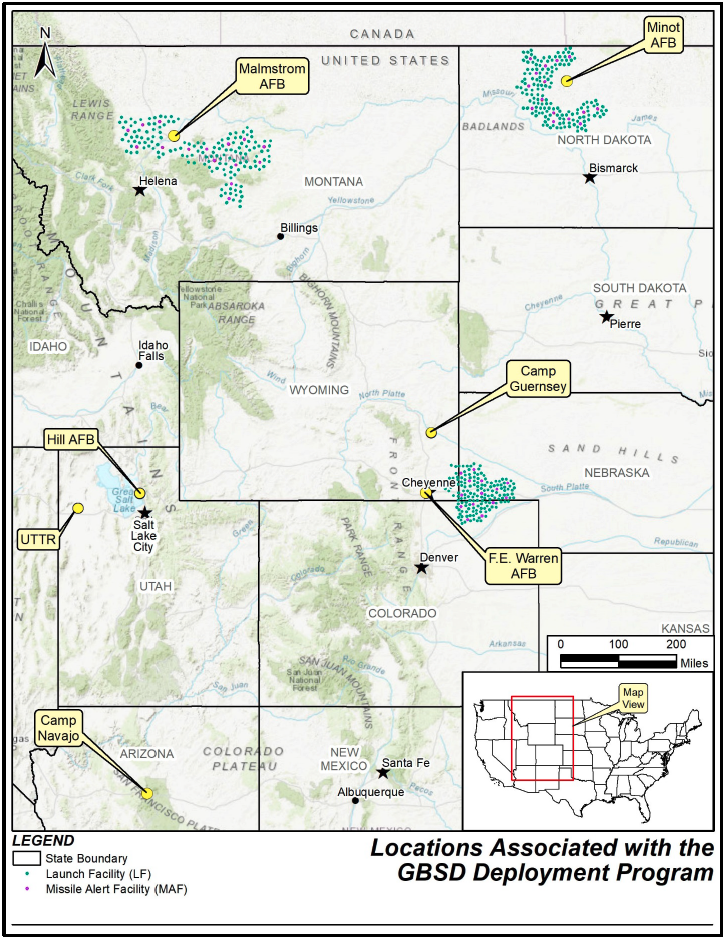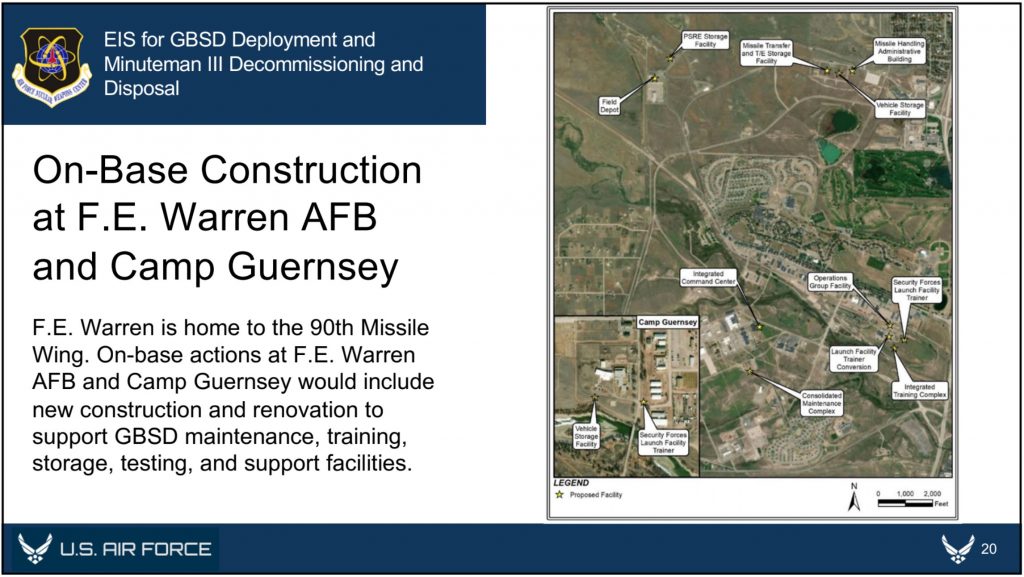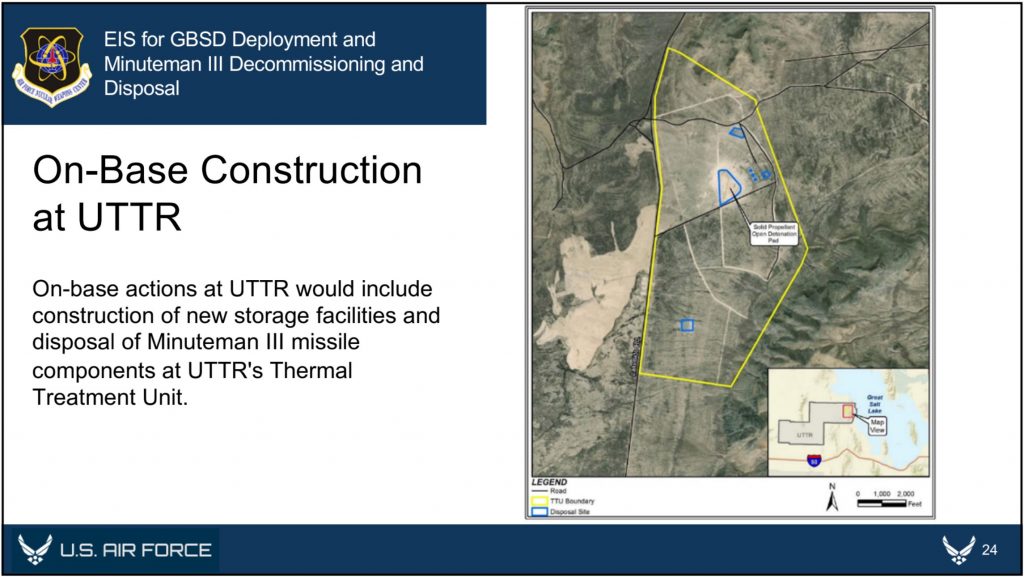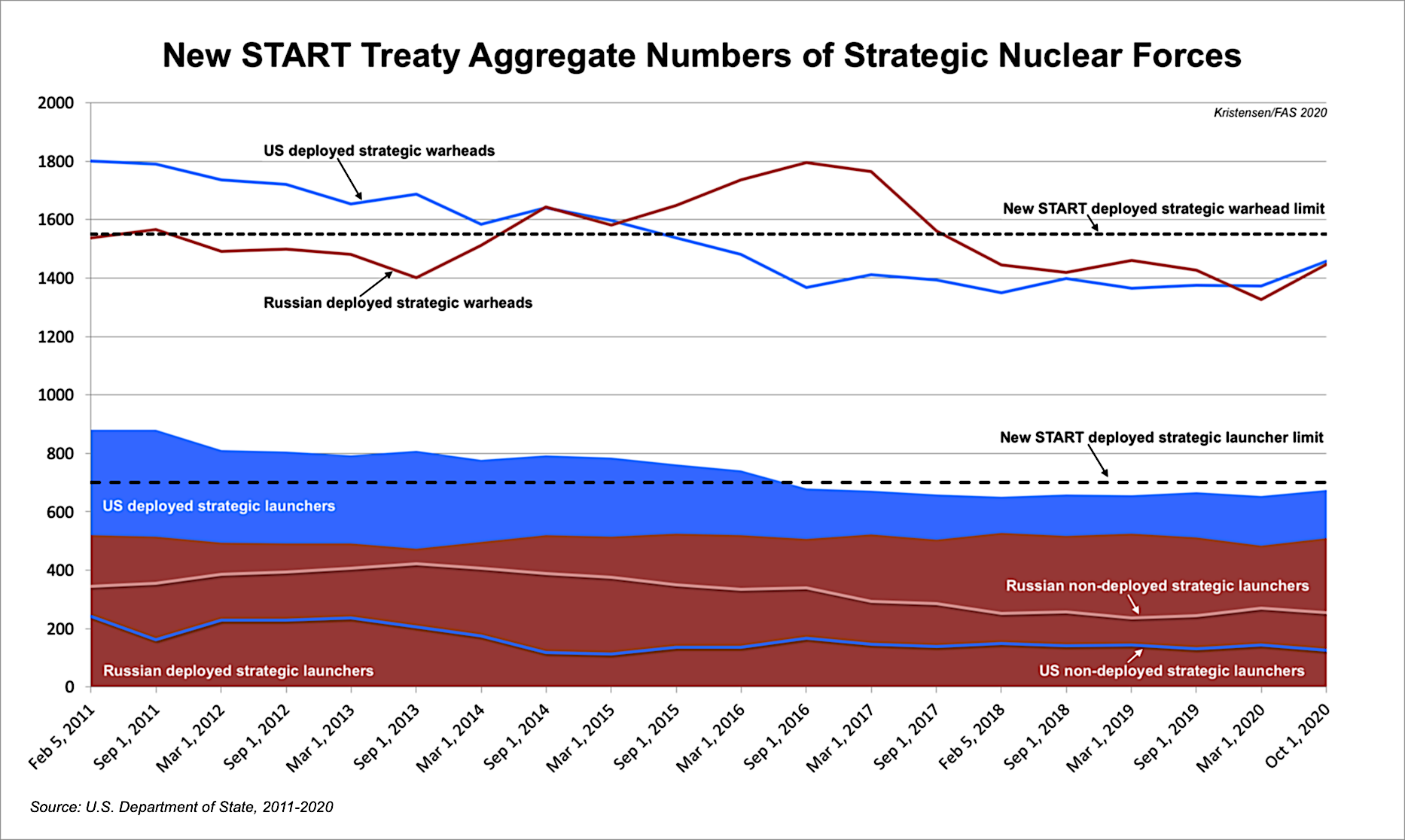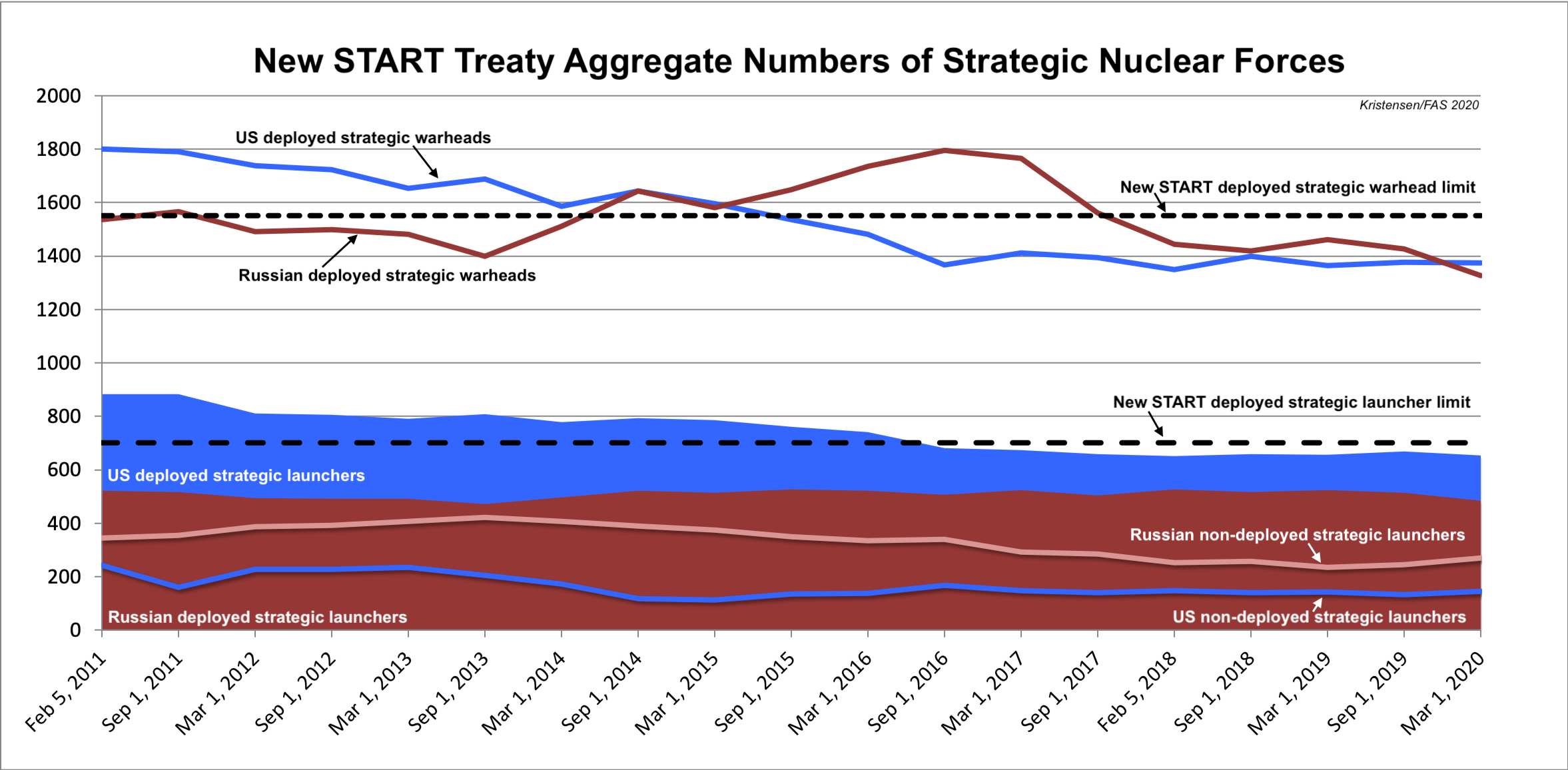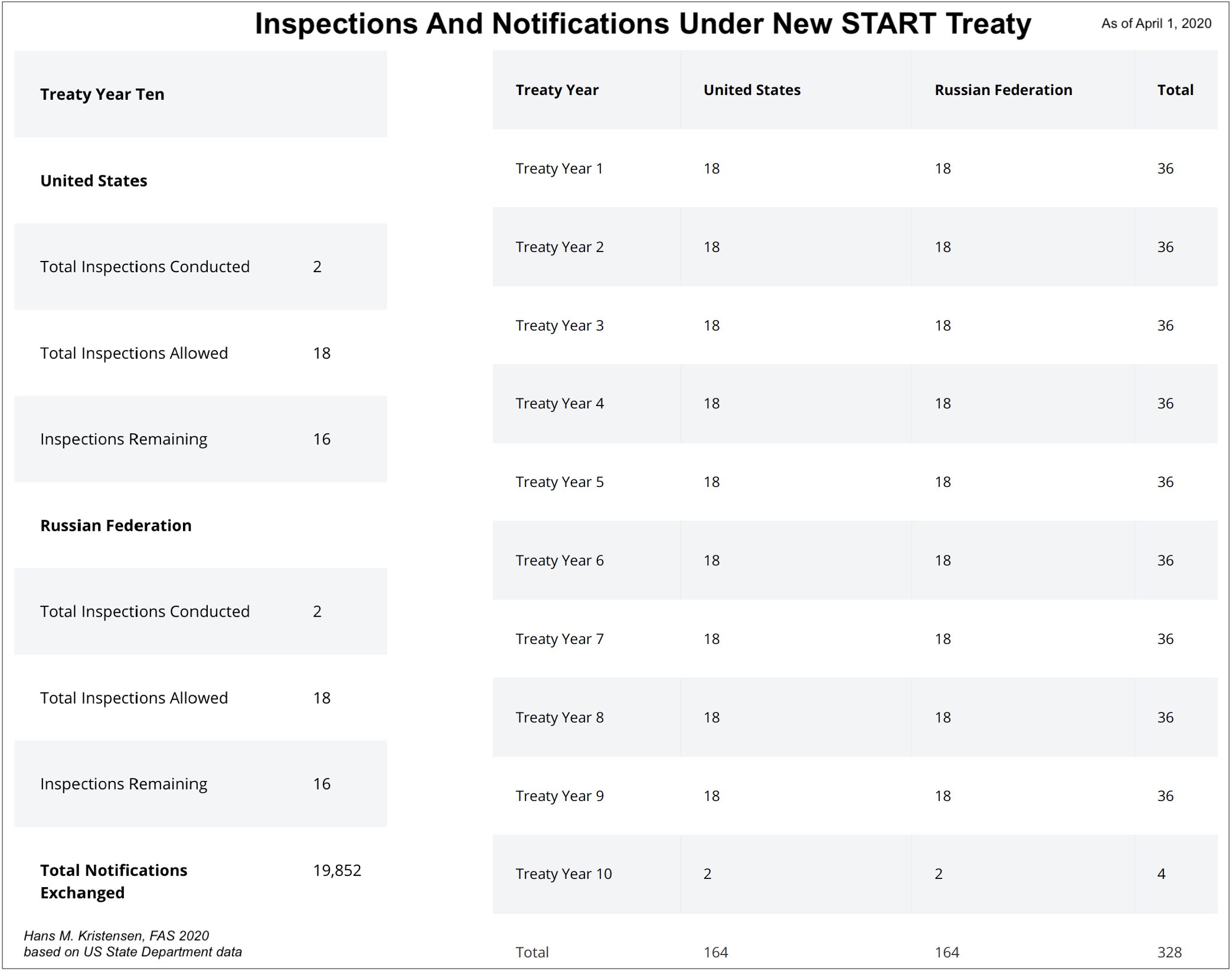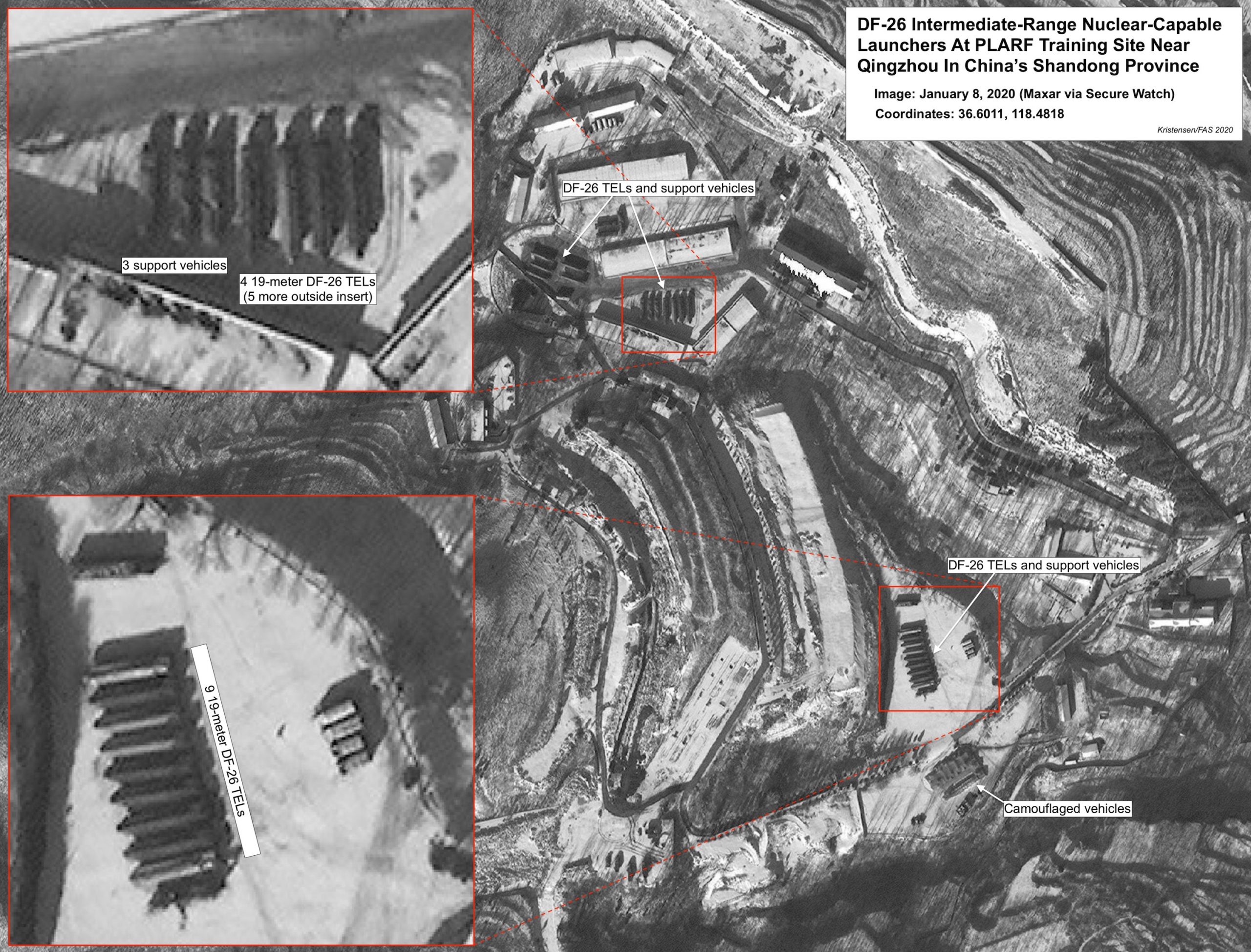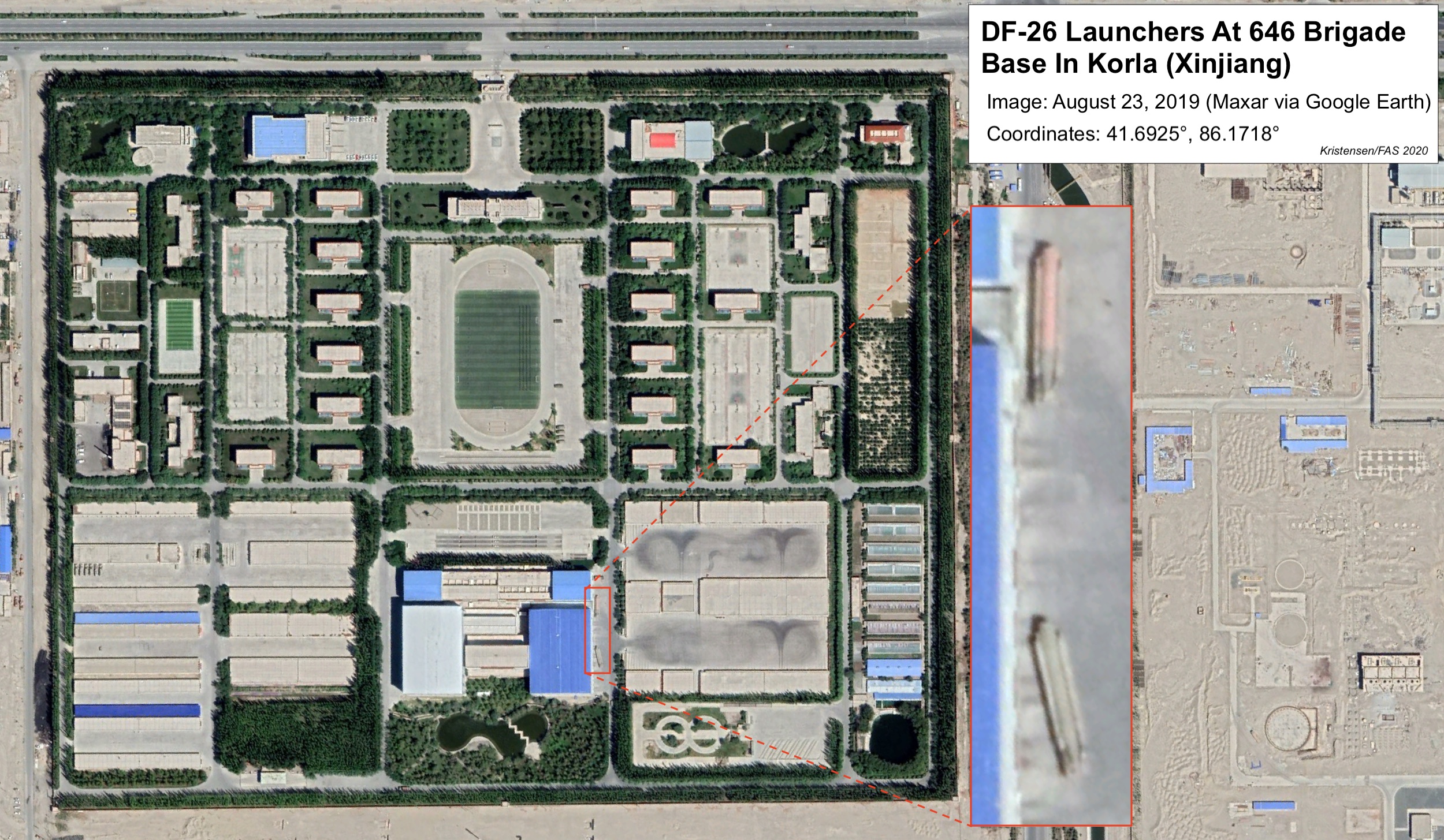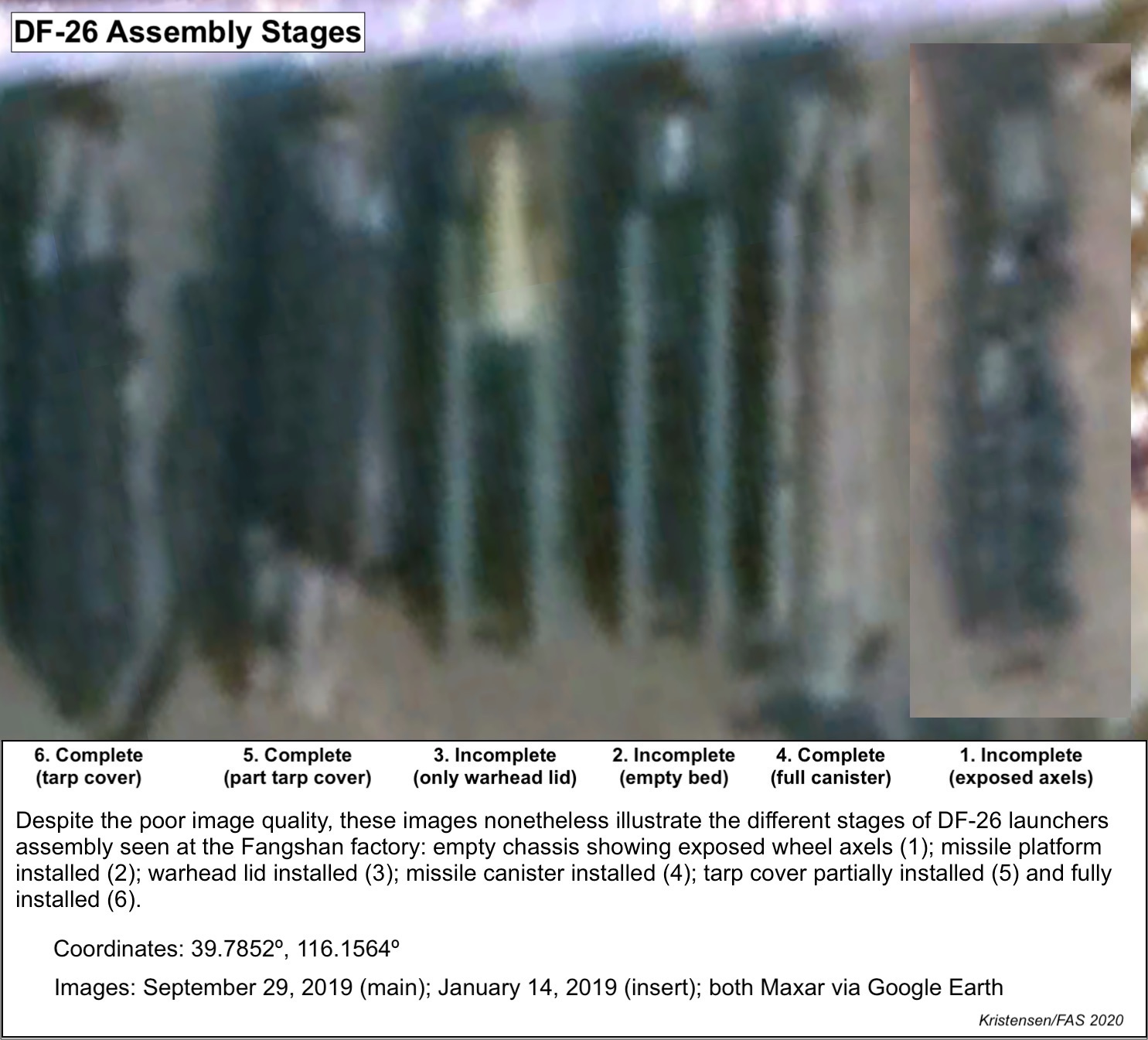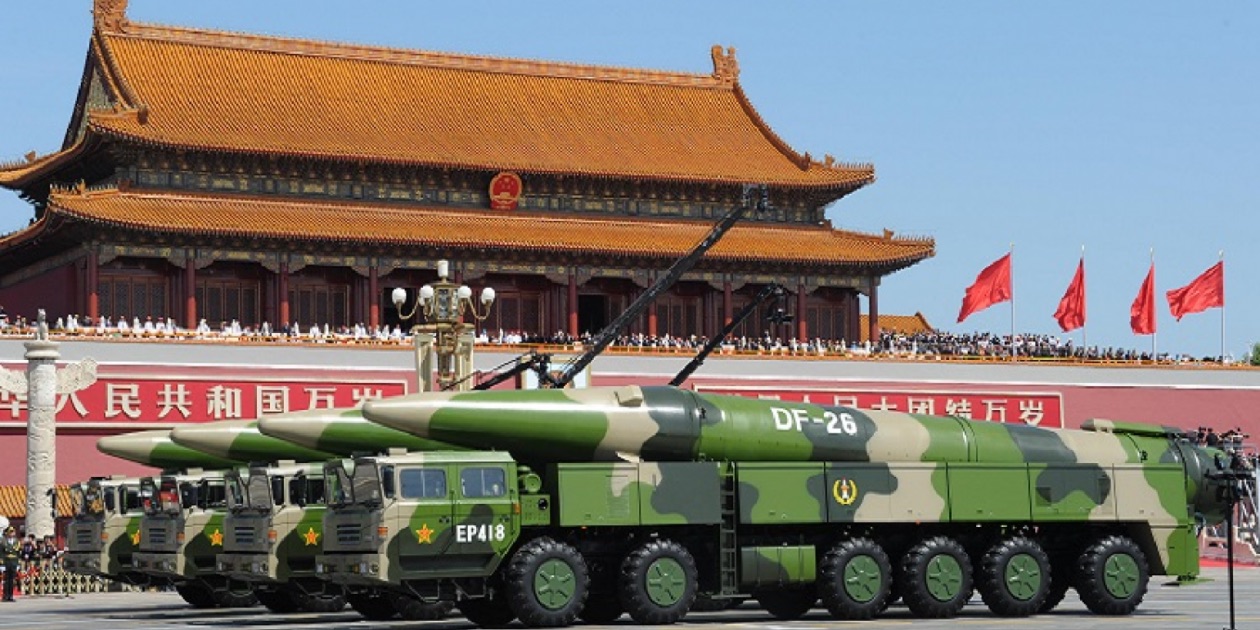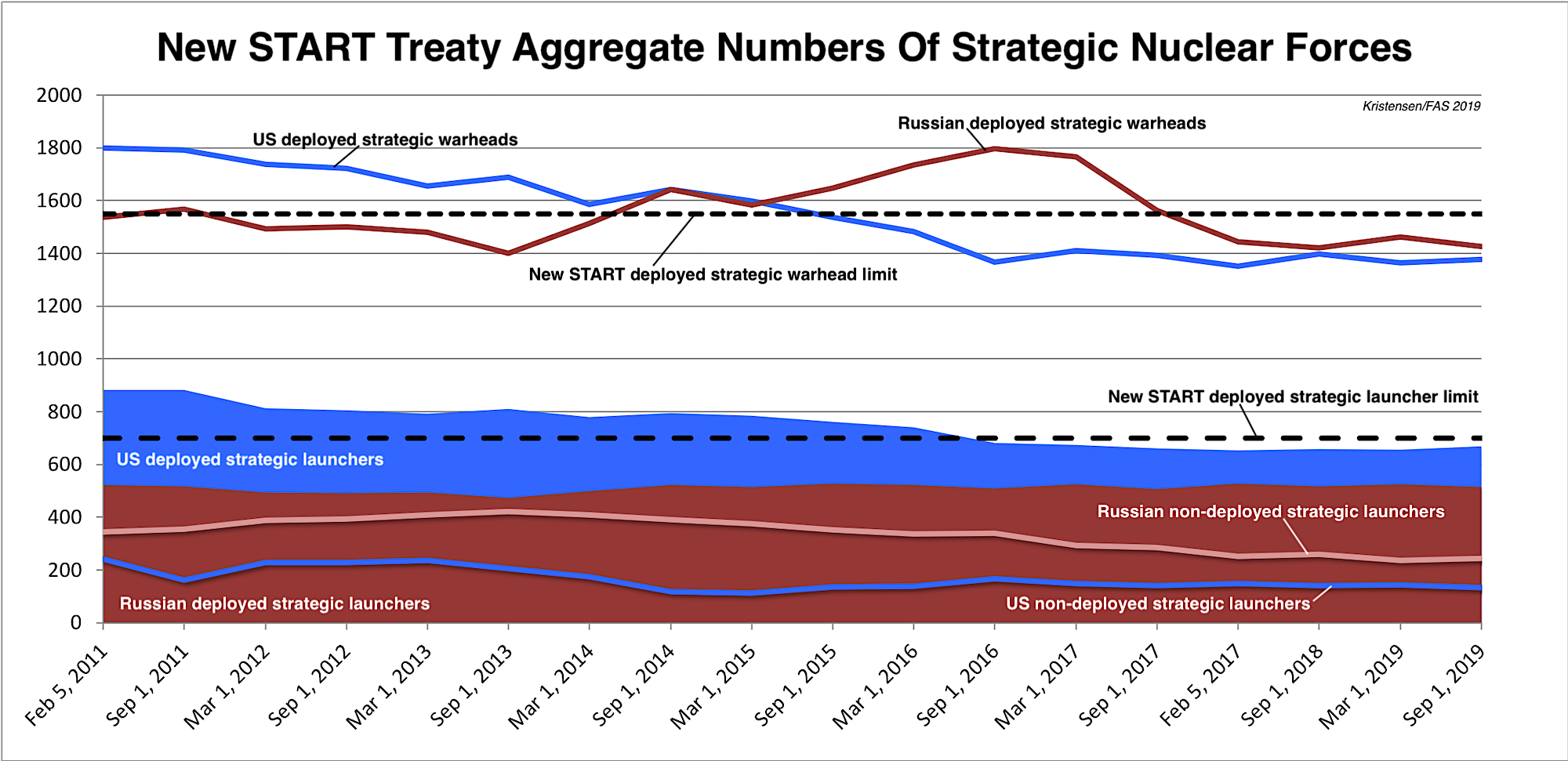Trump Administration Again Refuses To Disclose Nuclear Weapons Stockpile Size
The Trump administration has denied a request from the Federation of American Scientists to disclose the size of the US nuclear weapons stockpile and the number of dismantled warheads.
The denial was made by the Department of Defense Formerly Restricted Data Declassification Working Group (FDR DWG) in response to a petition from Steven Aftergood, director of the FAS Project on Government Secrecy, “that the Department of Energy (and the Department of Defense) authorize declassification of the size of the total U.S, nuclear stockpile and the number of weapons dismantled as of the end of fiscal year 2020.”
The decision to deny release of the data contradicts past US disclosure of such information, undercuts US criticism of secrecy in other nuclear-armed states, and weakens US ability to document its adherence to the nuclear Non-Proliferation Treaty. As Aftergood explained in the petition letter:
[su_quote]We believe that the reasons that led to the previous declassifications of stockpile information are still valid. The benefits of declassification are substantial while the detrimental consequences, if any, are insignificant.
As the first nuclear weapons state, the United States should strive to set a global example for clarity and transparency in nuclear weapons policy by disclosing its current stockpile size. Ambiguity is not helpful to anyone in this context.
Far from diminishing security, a credible USG account of its stockpile size both enhances deterrence and serves as a confidence building measure. Even if other nations do not immediately follow our lead, stockpile declassification sends a valuable message. And at a time when the future of US nuclear weapons policy is under discussion in Congress and elsewhere, stockpile disclosure also helps to provide a factual foundation for ongoing public deliberation.[/su_quote]
In its denial letter, the DOD Formerly Restricted Data Declassification Working Group (FDR DWG) did not respond to these points and gave no reason for the denial other than stating that “the information requested cannot be declassified at this time.”
Stockpile Size and Developments
The decision to deny declassification of the warhead stockpile and dismantlement numbers contradicts the publication of such data between 2010 and 2017 during which the Obama administration released annual numbers as well as the entire history of the stockpile size going back to 1945.
The decision also contradicts the decision in 2018 to declassify the data for 2017, the first year of the Trump administration.
In 2019, however, the Trump administration suddenly, and without explanation, decided to withhold the stockpile data.
The available data shows significant fluctuations in the size of the US stockpile over the years depending on how the various administrations increased or decreased the number of nuclear weapons. The graph below shows the size of the stockpile over the years and the in- and out-flux of warheads from the stockpile. As far as we can gauge, the stockpile has remained relatively stable for the past three years at around 3,800 warheads. And the number of warheads dismantled per year is probably currently in the order of 300-350.
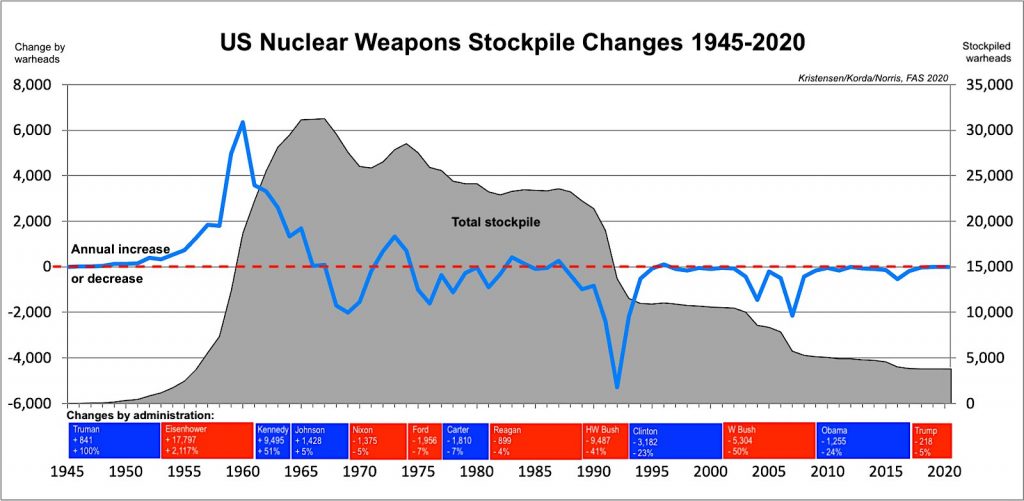
The size of the US nuclear weapons stockpile has fluctuated considerably over the years but remained relatively stable during the Trump administration. Click on image to view full size.
Implications and Recommendations
The decision by the Trump administration to deny declassification of the nuclear weapons stockpile size and dismantlement numbers contradict release of such data in the past for no apparent reason.
The increased secrecy of the US nuclear weapons arsenal comes at a time when the Trump administration has been criticizing China for “its secretive, nuclear crash buildup…” The administration’s criticism would carry a lot more weight if it didn’t hide its own stockpile behind a “great wall of secrecy.”
In addition to undercutting the US ability to push for greater transparency among other nuclear-armed states, the decision to classify warhead stockpile and dismantlement data also weakens the ability of the United States to demonstrate good faith on its efforts to continue to reduce its nuclear arsenal in the context of the upcoming review conference of the nuclear Non-Proliferation Treaty. The decision enables conspiracists to spread false rumors that the United States is secretly increasing its nuclear arsenal.
The incoming Biden administration should overturn the Trump administration’s excessive and counterproductive nuclear secrecy and restore transparency of the US nuclear warhead stockpile and dismantlement data.
Background Information:
This publication was made possible by generous contributions from the John D. and Catherine T. MacArthur Foundation, the New Land Foundation, the Ploughshares Fund, and the Prospect Hill Foundation. The statements made and views expressed are solely the responsibility of the authors.
USAF Plans To Expand Nuclear Bomber Bases
The US Air Force is working to expand the number of strategic bomber bases that can store nuclear weapons from two today to five by the 2030s.
The plan will also significantly expand the number of bomber bases that store nuclear cruise missiles from one base today to all five bombers bases by the 2030s.
The expansion is the result of a decision to replace the non-nuclear B-1B bombers at Ellsworth AFB and Dyess AFB with the nuclear B-21 over the next decade-and-a-half and to reinstate nuclear weapons storage capability at Barksdale AFB as well.
The expansion is not expected to increase the total number of nuclear weapons assigned to the bomber force, but to broaden the infrastructure to “accommodate mission growth,” Air Force Global Strike Command Commander General Timothy Ray told Congress last year.
Nuclear Bomber Base Expansion
The Air Force announced in May 2018 that the B-21 would replace the B-1B and B-2A bombers and be deployed at Ellsworth AFB, Dyess AFB, and Whiteman AFB. The commander of the strategic bomber force later explained in a video address to the B-1B bases that “the B-21 will bring significant changes to each location, to include the reintroduction of nuclear mission requirements.”
Since the B-1B was replaced in the nuclear war plan by the B-2A in 1997 and all B-1B bombers were denuclearized in 2011, the effect of the B-21 bomber program is that nuclear bomber operations will increase from the three bases today to five bases in the future (see map):
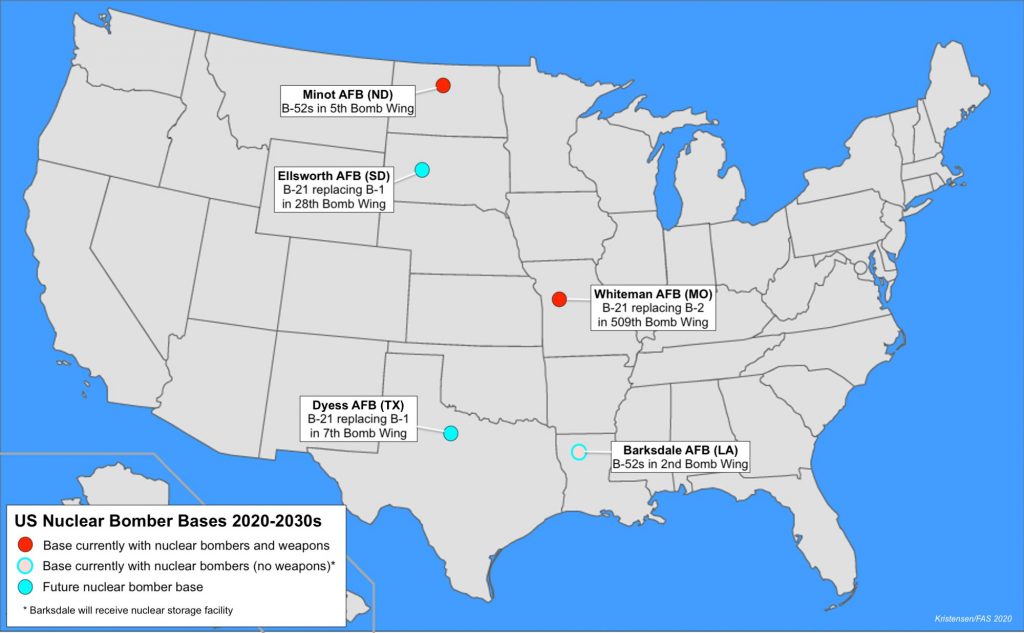
The Air Force plans to increase nuclear weapons storage capacity at bomber bases from two locations today to five in the future. Click map to view full size.
The Air Force previously planned for the B-21 to replace the B-2A no later than 2032 and the B-1Bs no later than 2036, though those dates may have shifted some since.
The effect of the integration of the B-21 is that bases with nuclear stealth bombers will increase from one today (Whiteman AFB) to three in the future.
The modernization plan also appears to significantly expand the location of nuclear cruise missiles from one base today (Minot AFB) to all five bomber bases by the late-2030s. The LRSO is scheduled to begin entering the arsenal in 2030 (see table):
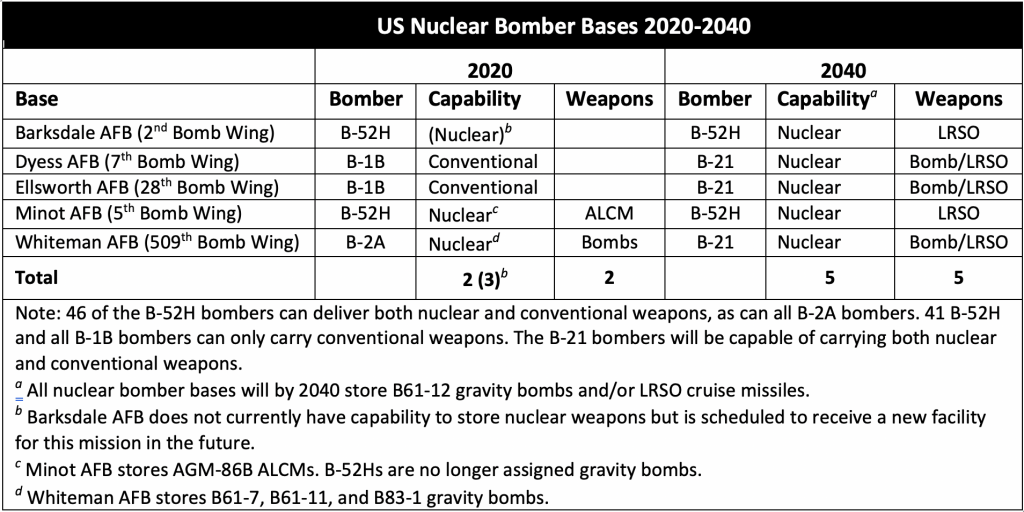
The US Air Force plans a significant expansion of nuclear bomber bases and their capabilities. Click table to view full size.
Nuclear Storage Facilities
A key element of the base upgrades to operate the B-21 involves the construction of a new nuclear weapons storage facility at each base: a Weapons Generation Facility (WGF). The new facility is different than the Weapons Storage Areas (WSAs) that that the Air Force built during the Cold War because it will integrate maintenance and storage mission sets into the same facility. The WGF will have a footprint of roughly 35 acres and include an approximately 52,000-square-foot (4,860 square meters) building as well as a 17,600 square-foot munitions maintenance building. The Air Force says the WGF will be “unique to the B-21 mission” and designed to provide a “safer and more secure location for the storage of Air Force nuclear munitions.”
An WGF is also under construction at F.E. Warren AFB for storage of ICBM warheads.
A draft Environmental Impact Statement recently posted by the Air Force shows the planned location of the nuclear weapons storage facility at Dyess and Ellsworth air force bases. At Dyess AFB, the intension is to build facility at the northern end of the base near the current munitions depot (see map below):

The Air Force plans to add nuclear weapons storage capacity to Dyess Air Force Base in Texas. Click on map to view full size.
At Ellsworth AFB, the Air Force has identified two preferred locations: one at the northern end near the munitions depot, and one at the southern end near the aircraft alert apron (see map below):

The Air Force plans to add nuclear weapons storage capacity to Ellsworth Air Force Base in South Dakota. Click on map to view full size.
Although Barksdale AFB is not scheduled to receive the B-21, preparations are underway to reinstate the capability to store nuclear weapons at the base. The capability was lost when the Air Force last decade consolidated operational nuclear ALCM storage at Minot AFB. Once completed, the new WGF will enable the base to store nuclear LRSO cruise missiles for delivery by the B-52s.
Nuclear Bomber Force Increase
The B-21 bomber program is expected to increase the overall size of the US strategic bomber force. The Air Force currently operates about 158 bombers (62 B-1B, 20 B-2A, and 76 B-52H) and has long said it plans to procure at least 100 B-21 bombers. That number now appears [https://www.airforcemag.com/article/strategy-policy-9/] to be at least 145, which will increase the overall bomber force by 62 bombers to about 220. There are currently nine bomber squadrons, a number the Air Force wants to increase to 14 (each base has more than one squadron).
During an interview with reporters in April, the head of AFGSC, General Timothy Ray, reportedly said the 220 number was a “minimum, not a ceiling” and added: “We as the Air Force now believe it’s over 220.” Whether Congress will agree to pay for that many B-21s remains to be seen.
The fielding of large numbers of nuclear-capable B-21 bombers has implications for the future development of the US nuclear arsenal. Under the New START treaty, the United States has declared it will deploy no more than 60 nuclear bombers. Although the treaty will lapse in 2026 (after a five-year maximum extension), it serves as the baseline for long-term nuclear force structure planning.
Unless the Air Force limits the number of nuclear-equipped B-21 bombers to the number of B-2As operated today, the number of nuclear bombers would begin to exceed the 60 deployed nuclear bomber pledge by 2028 (assuming an annual production of nine aircraft and two-year delay in deployment of the first nuclear unit). By 2035, the number of deployed nuclear bombers could have doubled compared with today (see graph below):
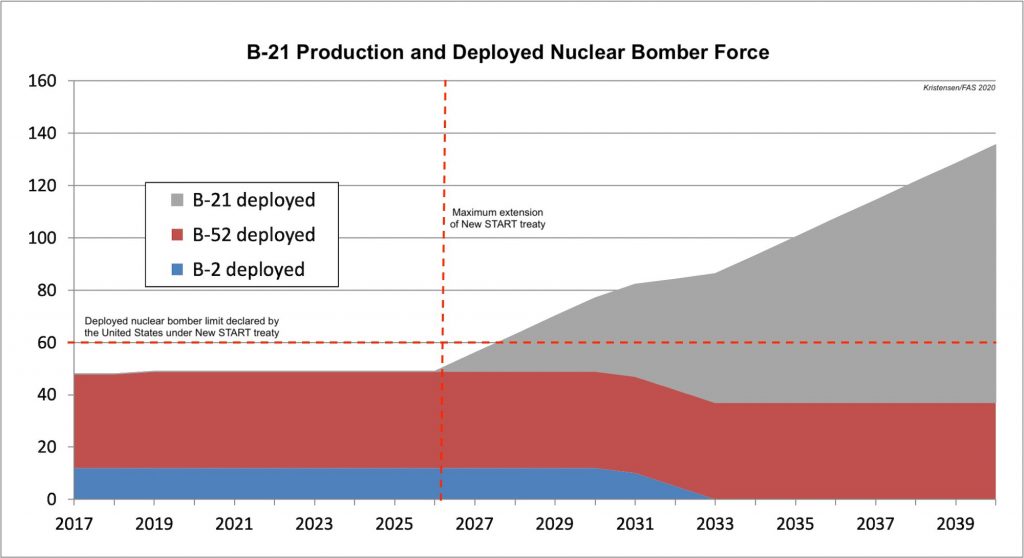
Unless nuclear B-21 bombers are not limited, the future nuclear bomber force could significantly exceed the bomber force under the current New START treaty. Click graph to view full size.
It is difficult to imagine a military justification for such an increase in the number of nuclear bombers – even without New START. One would hope that the number of nuclear B-21s will be limited to well below the total number. Although the New START treaty would have expired before this becomes a a legal issue, it would already now send the wrong message to other nuclear-armed states about US long-term intensions, deepen suspicion and “Great Power Competition,” and could complicate future arms control talks.
In the short term, the incoming Biden administration should commit the United States to not increase the number of nuclear bombers beyond those planned under the New START treaty, and it should urge Russia to make a similar declaration about the size of its nuclear bomber force.
See also: Nuclear Notebook: US nuclear force, 2020
This publication was made possible by generous contributions from the John D. and Catherine T. MacArthur Foundation, the New Land Foundation, the Ploughshares Fund, and the Prospect Hill Foundation. The statements made and views expressed are solely the responsibility of the authors.
Environmental Assessment Reveals New Details About the Air Force’s ICBM Replacement Plan
Any time a US federal agency proposes a major action that “has the potential to cause significant effects on the natural or human environment,” they must complete an Environmental Impact Statement, or EIS. An EIS typically addresses potential disruptions to water supplies, transportation, socioeconomics, geology, air quality, and other factors in great detail––meaning that one can usually learn a lot about the scale and scope of a federal program by examining its Environmental Impact Statement.
What does all this have to do with nuclear weapons, you ask?
Well, given that the Air Force’s current plan to modernize its intercontinental ballistic missile force involves upgrading hundreds of underground and aboveground facilities, it appears that these actions have been deemed sufficiently “disruptive” to trigger the production of an EIS.
To that end, the Air Force recently issued a Notice of Intent to begin the EIS process for its Ground-Based Strategic Deterrent (GBSD) program––the official name of the ICBM replacement program. Usually, this notice is coupled with the announcement of open public hearings, where locals can register questions or complaints with the scope of the program. These hearings can be influential; in the early 1980s, tremendous public opposition during the EIS hearings in Nevada and Utah ultimately contributed to the cancellation of the mobile MX missile concept. Unfortunately, in-person EIS hearings for the GBSD have been cancelled due to the ongoing Covid-19 pandemic; however, they’ve been replaced with something that might be even better.
The Air Force has substituted its in-person meetings for an uncharacteristically helpful and well-designed website––gbsdeis.com––where people can go to submit comments for EIS consideration (before November 13th!). But aside from the website being just a place for civic engagement and cute animal photos, it is also a wonderful repository for juicy––and sometimes new––details about the GBSD program itself.
The website includes detailed overviews of the GBSD-related work that will take place at the three deployment bases––F.E. Warren (located in Wyoming, but responsible for silos in Wyoming, Colorado, and Nebraska), Malmstrom (Montana), and Minot (North Dakota)––plus Hill Air Force Base in Utah (where maintenance and sustainment operations will take place), the Utah Test and Training Range (where missile storage, decommissioning, and disposal activities will take place), Camp Navajo in Arizona (where rocket boosters and motors will be stored), and Camp Guernsey in Wyoming (where additional training operations will take place).
Taking a closer look at these overviews offers some expanded details about where, when, and for how long GBSD-related construction will be taking place at each location.
For example, previous reporting seemed to indicate that all 450 Minuteman Launch Facilities (which contain the silos themselves) and “up to 45” Missile Alert Facilities (each of which consists of a buried and hardened Launch Control Center and associated above- or below-ground support buildings) would need to be upgraded to accommodate the GBSD. However, the GBSD EIS documents now seem to indicate that while all 450 Launch Facilities will be upgraded as expected, only eight of the 15 Missile Alert Facilities (MAF) per missile field would be “made like new,” while the remainder would be “dismantled and the real property would be disposed of.”
Currently, each Missile Alert Facility is responsible for a group of 10 Launch Facilities; however, the decision to only upgrade eight MAFs per wing––while dismantling the rest––could indicate that each MAF could be responsible for up to 18 or 19 separate Launch Facilities once GBSD becomes operational. If this is true, then this near-doubling of each MAF’s responsibilities could have implications for the future vulnerability of the ICBM force’s command and control systems.
The GBSD EIS website also offers a prospective construction timeline for these proposed upgrades. The website notes that it will take seven months to modernize each Launch Facility, and 12 months to modernize each Missile Alert Facility. Once construction begins, which could be as early as 2023, the Air Force has a very tight schedule in order to fully deploy the GBSD by 2036: they have to finish converting one Launch Facility per week for nine years. It is expected that construction and deployment will begin at F.E. Warren between 2023 and 2031, followed by Malmstrom between 2025 and 2033, and finally Minot between 2027 and 2036.
Although it is still unclear exactly what the new Missile Alert Facilities and Launch Facilities will look like, the EIS documents helpfully offer some glimpses of the GBSD-related construction that will take place at each of the three Air Force bases over the coming years.
In addition to the temporary workforce housing camps and construction staging areas that will be established for each missile wing, each base is expected to receive several new training, storage, and maintenance facilities. With a single exception––the construction of a new reentry system and reentry vehicle maintenance facility at Minot––all of the new facilities will be built outside of the existing Weapons Storage Areas, likely because these areas are expected to be replaced as well. As we reported in September, construction has already begun at F.E. Warren on a new underground Weapons Generation Facility to replace the existing Weapons Storage Area, and it is expected that similar upgrades are planned for the other ICBM bases.
Finally, the EIS documents also provide an overview of how and where Minuteman III disposal activities will take place. Upon removal from their silos, the Minutemen IIIs will be transported to their respective hosting bases––F.E. Warren, Malmstrom, or Minot––for temporary storage. They will then be transported to Hill Air Force Base, the Utah Test and Training Range (UTTR), or Camp Najavo, in Arizona. It is expected that the majority of the rocket motors will be stored at either Hill AFB or UTTR until their eventual destruction at UTTR, while non-motor components will be demilitarized and disposed of at Hill AFB. To that end, five new storage igloos and 11 new storage igloos will be constructed at Hill AFB and UTTR, respectively. If any rocket motors are stored at Camp Navajo, they will utilize existing storage facilities.
After the completion of public scoping on November 13th (during which anyone can submit comments to the Air Force via Google Form), the next public milestone for the GBSD’s EIS process will occur in spring 2022, when the Air Force will solicit public comments for their Draft EIS. When that draft is released, we should learn even more about the GBSD program, and particularly about how it impacts––and is impacted by––the surrounding environment. These particular aspects of the program are growing in significance, as it is becoming increasingly clear that the US nuclear deterrent––and particularly the ICBM fleet deployed across the Midwest––is uniquely vulnerable to climate catastrophe. Given that the GBSD program is expected to cost nearly $264 billion through 2075, Congress should reconsider whether it is an appropriate use of public funds to recapitalize on elements of the US nuclear arsenal that could ultimately be rendered ineffective by climate change.
Additional background information:
- United States nuclear forces, 2020
-
Construction of New Underground Nuclear Warhead Facility At Warren AFB
This publication was made possible by generous contributions from the Carnegie Corporation of New York, the John D. and Catherine T. MacArthur Foundation, the New Land Foundation, the Ploughshares Fund, and the Prospect Hill Foundation. The statements made and views expressed are solely the responsibility of the author.
Image sources: Air Force Global Strike Command. 2020. “Environmental Impact Statement for the Ground-Based Strategic Deterrent Deployment and Minuteman III Decommissioning and Disposal: Public Scoping Materials.”
US Officials Give Confusing Comparisons Of US And Russian Nuclear Forces
October 22, 2020 [updated]
In their effort to paint the New START treaty as insufficient and a bad deal for the United States and its allies, Trump administration official have recently made statements suggesting the treaty limits the US nuclear arsenal more than it limits the Russian arsenal.
New START imposes the same restrictions on US and Russian strategic nuclear forces.
During a virtual conference organized by the Heritage Foundation on October 13, Marshall Billingslea, special presidential envoy for arms control, stated: “What we’ve indicated to the Russians is that we are in fact willing to extend the New START Treaty for some period of time provided that they agree to a limitation, a freeze, in their nuclear arsenal. We’re willing to do the same. I don’t see how it’s in anyone’s interests to allow Russia to build up its inventory of these tactical nuclear weapons systems with which they like to threaten NATO…We cannot agree to a construct that leaves unaddressed 55 percent or more of the Russian arsenal.”
One week later, in an interview on National Public Radio, Billingslea added: “The New START treaty constraints…92 percent of the entire U.S. arsenal, of our deterrent” but “only covers 45 percent or less of the Russian arsenal…”
Finally, on October 21, Secretary of State Michal Pompeo repeated this talking point: “President Trump has made clear that the New START Treaty by itself is not a good deal for the United States or our friends or allies. Only 45 percent of Russia’s nuclear arsenal is subject to numerical limits, posing a threat to the United States and our NATO allies. Meanwhile, that agreement restricts 92 percent of America’s arsenal that is subject to the limits contained in the New START agreement.”
Pompeo and Billingslea didn’t specify what they meant by “arsenal” and the reaction from nuclear weapons analysts – ourselves included – was bewilderment. Most assumed “arsenal” was referring warheads, but the numbers don’t seem to fit with the percentages and descriptions in the statements. Interestingly, the percentages and categories seem to work better for launchers, unless one does a back-of-the-envelope calculation.
Matching Comparison With Warheads
Our first step was to analyze the statements and see if we could make them fit with our understanding of the size and composition of the nuclear arsenals. If we assume the percentages and descriptions refer to warhead numbers, then we see the following potential options:
Option 1: The 45% refers to New START warhead limit for deployed strategic warheads (1,550). If this were the case, then Russia’s entire stockpile would only consist of 3,445 warheads, which we doubt. Our estimate is 4,310. For the United States, 1,550 would only constitute 41% of the US stockpile, not 92% as stated by Billingslea.
Option 2: The 45% refers to the number of strategic warheads that can be loaded onto ICBMs and SLBMs but not bomber weapons. New START counts actual numbers of warheads on deployed ICBMs and SLBMs, but not those on bomber bases. According to our estimate of Russian forces, their ICBMs can load 1,136 warheads and SLBMs can load 720 warheads, a total of 1,856 warheads. That would constitute 43% of the total stockpile of 4,310 warheads (our estimate). It would of course be embarrassing if the US officials have been using our numbers instead of those of the US Intelligence Community. Even so, that methodology does not fit with the 92% comparison used for the United States. US ICBMs and SLBMs can load a maximum of 2,720 warheads, by our estimate, or 72% of the stockpile. And Billingslea explicitly says the US comparison includes the “entire” arsenal.
Option 3: The 45% refers to the total number of strategic warheads in the Russian arsenal (deployed and non-deployed). If that were the case, then the remaining 55% of 3,025 warheads would be non-strategic warheads, far more than the “up to 2,000” stated in the Nuclear Posture Review. And it would imply a total stockpile of 5,500 warheads, far more than the number of warhead spaces on launchers.
Option 4: The percentage numbers come from a simplistic back-of-the-envelope calculation. The Russian 45% is 1,550 (New START limit) / 1,550 (reserve) + 2,000 (tactical). The US 92% is 1,550 (New START limit) / 1,550 (reserve) + 150 (tactical). Those numbers don’t fully match the stockpiles and statements but can explain the comparison. (We are indebted to Pavel Podvig for suggesting this option.)
Billingslea and Pompeo both compared the Russian restrictions to those affecting the US arsenal, but they described it differently.
Billingslea said New START “constraints…92 percent of the entire U.S. arsenal, of our deterrent…” (emphasis added). Since we know the approximate size of the total US stockpile (about 3,800 warheads), 92% would constitute 3,496 warheads, far more than the treaty’s limit of 1,550 deployed strategic warheads. But the count would be close to the number of strategic warheads that can be loaded onto strategic launchers (3,570 by our estimate), leaving about 300 non-strategic warheads.
Pompeo said that New START “restricts 92 percent of America’s arsenal that is subject to the limits” (emphasis added), which is different than what Billingslea said because it doesn’t appear to include non-deployed strategic warheads or tactical warheads, two categories that are not subject to the treaty limits.
Matching Comparison With Launchers
Our next step was to analyze the statements to see how they compare with the number of launchers that can deliver nuclear warheads. New START limits both sides to no more than 800 strategic launchers in total, of which no more than 700 can be deployed at any given time.
In the latest set of aggregate numbers released by the US State Department, the United States is listed with exactly 800 launchers in total, of which 675 are deployed. Russia is listed with a total of 764 launchers, of which 510 are deployed.
While complaining about limits on US and Russian weapons, neither Billingslea nor Pompeo mentions this US strategic advantage of 165 deployed launchers, a number that exceeds the number of Minuteman IIIs in one missile wing and corresponds to more than half of the entire Russian ICBM force.
For the United States, if the 800 total strategic launchers constitute 92% of all US nuclear launchers (“entire” arsenal), then that would imply the existence of another 70 launchers, which potentially could refer to non-strategic fighter-bombers assigned missions with gravity bombs.
For Russia, if the 764 total strategic launchers constitute 45% of all its nuclear launchers, that would potentially imply that Russia has 1,698 total nuclear launchers, of which 934 would be launchers of non-strategic nuclear weapons.
We don’t yet know if this is the case. But the percentages mentioned by Billingslea and Pompeo appear to fit better if they refer to launchers than warheads, unless one applies the Option 4 calculation described above. The Trump administration has been particularly critical about Russia’s development of new types of strategic-range weapons that are not covered by the New START treaty, just like it has criticized that Russia’s non-strategic nuclear weapons are not covered by any arms control agreement.
Context and Recommendations
The comparisons and descriptions of Russian and US nuclear forces presented by Billingslea and Pompeo are confusing. Some might suspect “fuzzy math” but until we see otherwise, we suspect the comparisons use real data. Option 4 above might represent the most likely explanation although it doesn’t fully match the stockpiles and descriptions provided by the officials.
When it comes to nuclear negotiations, it is incredibly important to be precise with official words and statements, in order to avoid misunderstandings or mischaracterizations. Unfortunately, the Trump administration has a habit of cherry-picking or spinning statistics in an apparent attempt to make existing and equitable arms control agreements seem like “bad deals” for the United States. Given this track record, we should view their statements here with skepticism and ask for clarification if they’re referring to warheads or launchers. We have done so but have not yet heard back from the State Department.
A one-year extension of New START is better than no extension, but it’s worse than a five-year extension because it creates uncertainty about the commitment to continue to limit force levels and unnecessarily shortens the time available to negotiate follow-on arrangements. There is no technical need to shorten the extension. If a new deal is made, the old one will fall away.
A freeze on warheads would be a welcoming new step and Russia’s acceptance of the idea is a breakthrough because it opens up possibilities for building on this idea in the future. But a freeze will not have much credibility or effect without verification and despite saying it would like “portal monitoring” the Trump administration has not presented a plan for how this would work or secured Moscow’s agreement. Verification of a total warhead freeze would be much more complex than verifying the New START treaty itself and one year may not be sufficient to do the work. Has the US military and intelligence community signed off on Russian inspectors monitoring every US warhead moving in and out of facilities? Have US allies in Europe agreed to allow Russian officials to monitor the bases where the US Air Force stores nuclear bombs?
Russia’s acceptance of a one-year New START extension and a declaration to freeze warhead levels is a significant compromise from its previous offer to unconditionally extend the treaty by five years with no warhead freeze.
The Trump administration’s “offer” of a one-year extension of New START and a one-year warhead freeze with no verification at the outset represents an astounding walk-back from its previous statements. Trump has repeatedly called New START a “bad deal” and the whole point of the talks was to “fix” what the administration claimed was inadequate verification, incorporate Russia’s new strategic weapons into the agreement, and get China onboard. And how many times have we heard that you can’t trust Russia because they violate every arms control agreement they have signed? Yet here we are. None of those “fixes” are attached to the one-year treaty extension and the administration now says it is willing to sign on to a warhead freeze without agreed verification measures with the Great Cheater.
There is nothing wrong with trying to broaden arms control to other weapons categories and countries. We strongly support that. But the last-minute flurry and attempts to shorten extension strongly suggest that the Trump administration has been more focused on creating chaos and to appear tough on Moscow and Beijing than to create nuclear arms control progress. The one-year timeline unnecessarily constrains both countries and could well mean that they would be in pretty much the same situation one year from now.
The inconvenient fact is that New START is working as designed and keeps the vast majority of Russian and US strategic arsenals in check, prevents either country from uploading thousands of extra warheads onto their deployed missiles, and offers a modicum of predictability in an otherwise unpredictable world.
Additional background information:
- Status of world nuclear forces, September 2020
- United States nuclear forces, 2020
- Russian nuclear forces, 2020
- At 11th Hour, New START Data Reaffirms Importance of Extending Treaty
This publication was made possible by generous contributions from the Carnegie Corporation of New York, the John D. and Catherine T. MacArthur Foundation, the New Land Foundation, the Ploughshares Fund, and the Prospect Hill Foundation. The statements made and views expressed are solely the responsibility of the authors.
At 11th Hour, New START Data Reaffirms Importance of Extending Treaty
Just four months before the New START treaty is set to expire, the latest set of so-called aggregate data published by the State Department shows the treaty is working and that both countries – despite tense military and political rhetoric – are keeping their vast strategic nuclear arsenals within the limits of the treaty.
The treaty caps the number of long-range strategic missiles and heavy bombers the two countries can possess to 800, with no more than 700 launchers and 1,550 warheads deployed. The treaty entered into force in February 2011, into effect in February 2018, and is set to expire on February 5, 2021 – unless the two countries agree to extend it for an additional five years.
Twice a year, the two countries have exchanged detailed data on their strategic forces. Of that data, the public gets to see three sets of numbers twice a year (1 March and 1 October): the aggregate data of deployed launchers, warheads attributed to those launchers, and total launchers. This time, the web-version helpfully includes the full data set (including a breakdown of US forces; it would be helpful is Moscow could also publish its breakdown) but the PDF-version does not.
This is the final set of periodic six-month aggregate data to be released, although a final set will probably be released if the treaty expires in February. If the treaty is extended for another five years, an additional ten data sets would probably be released.
The nearly ten years of aggregate data published so far looks like this:
Combined Forces
The latest set of this data shows the situation as of October 1, 2020. As of that date, the two countries possessed a combined total of 1,564 accountable strategic missiles and heavy bombers, of which 1,185 launchers were deployed with 2,904 warheads. That is a slight increase in the number of deployed launchers and warheads compared with six months ago (note: the combined warhead number is actually about 100 too high because each deployed bomber is counted as one weapon even though neither country’s bombers carry weapons under normal circumstances).
Compared with March 2020, the data shows the two countries combined increased the total number of strategic launchers by 10, increased combined deployed strategic launchers by 45, and increased the combined deployed strategic warheads by 205. Of these numbers, only the “10” is real; the other changes reflect natural fluctuations as launchers move in and out of maintenance or are being upgraded.
In terms of the total effect of the treaty, the data shows the two countries since February 2011 have cut 425 strategic launchers from their combined arsenals, reduced deployed strategic launchers by 218, and reduced the number of deployed strategic warheads by 433. However, it is important to remind that this warhead reduction is but a fraction (less than 6 percent) of the estimated 8,110 warheads that remain in the two countries combined nuclear weapons stockpiles (less than 4 percent if counting their total combined inventories of 12,170 stockpiled and retired (but yet to be dismantled) warheads).
The United States
The data shows the United States currently possessing 800 strategic launchers, the maximum number allowed by the treaty, of which 675 are deployed with 1,457 warheads attributed to them. This is an increase of 20 deployed strategic launchers and 84 deployed strategic warheads over the past 6 months. These are not actual increases but reflect normal fluctuations caused by launchers moving in and out of maintenance. The United States has not reduced its total inventory of strategic launchers since 2017.
The warhead numbers are interesting because they reveal that the United States now deploys 1,009 warheads on the 220 deployed Trident missiles on the SSBN fleet. That’s an increase of 82 warheads compared with March and the first time since 2015 that the United States has deployed more than 1,000 warheads on its submarines, or an average of 4-5 warheads per deployed missile. Overall, this accounts for nearly 70 percent of all the 1,457 warheads attributed to the deployed strategic launchers (nearly 72 percent if excluding the “fake” 50 bomber weapons included in the official count).
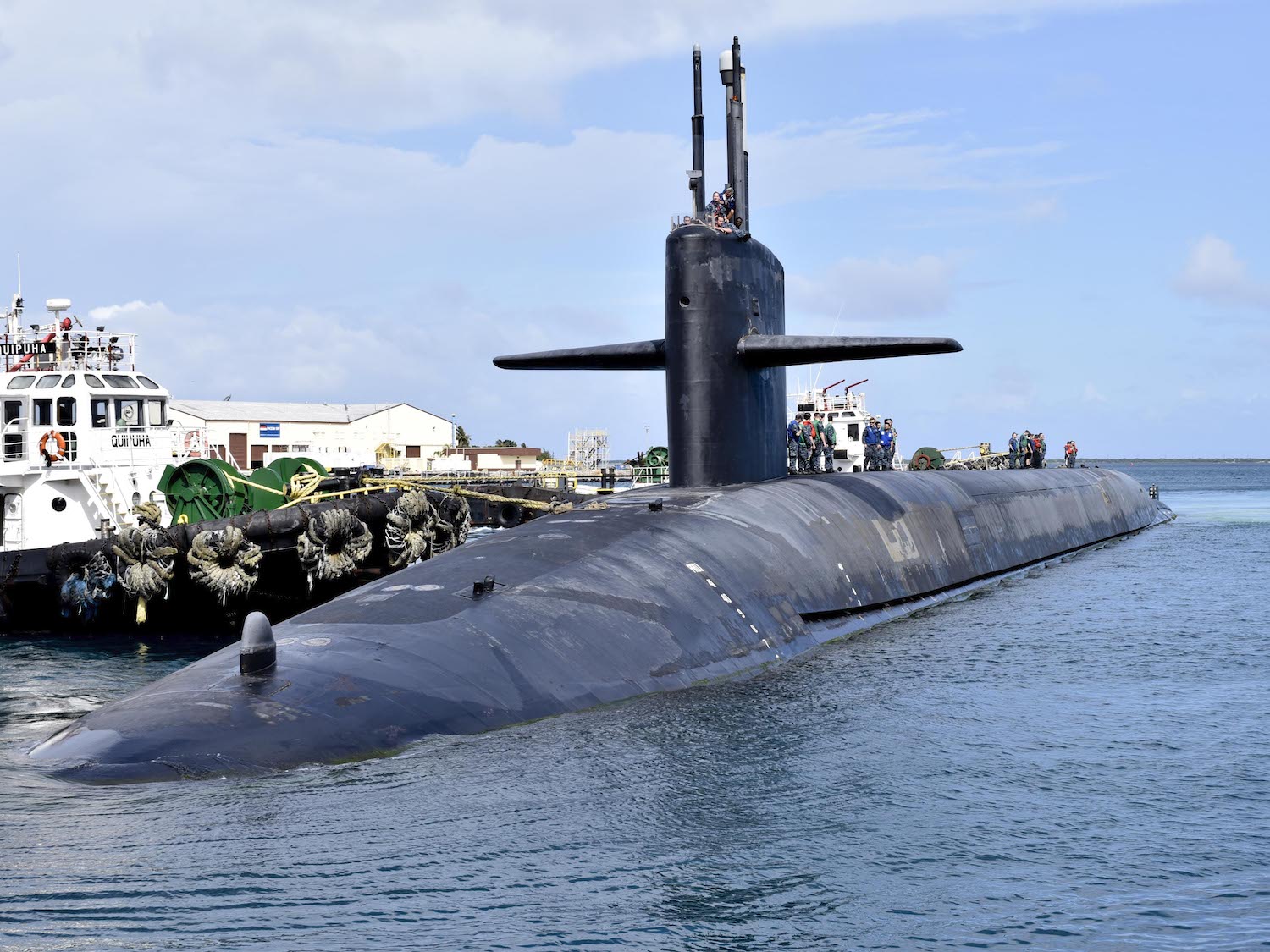
The New START data reveals that the United States as of October 1, 2020 deployed over 1,000 warheads on its fleet of ballistic missile submarines.
Compared with February 2011, the United States has reduced its inventory of strategic launchers by 324, deployed launchers by 207, and deployed strategic warheads by 343. While important, the warhead reduction represents only a small fraction (about 9 percent) of the 3,800 warheads that remain in the U.S. stockpile (less than 6 percent if counting total inventory of 5,800 stockpiled and retired (but yet to be dismantled) warheads).
The Russian Federation
The New START data shows Russia with an inventory of 764 strategic launchers, of which 510 are deployed with 1,447 warheads attributed to them. Compared with six months ago, this is an increase of 25 deployed launchers and 121 deployed strategic warheads. The change reflects fluctuations caused by launcher maintenance and upgrade work to new systems.
Compared with February 2011, Russia has cut its inventory of strategic launchers by 101, deployed launchers by 11, and deployed strategic warheads by 90. This modest warhead reduction represents about 2 percent of the estimated 4,310 warheads that remain in Russia’s nuclear weapons stockpile (not even 3 percent if counting the total inventory of 6,370 stockpiled and retired (but yet to be dismantled) Russian warheads).
Compared with 2011, the Russian reductions accomplished under New START are smaller than the U.S. reductions because Russia had fewer strategic forces than the United States when the treaty entered into force in 2011.
Build-up, What Build-up?
With frequent claims by U.S. officials and nuclear weapons advocates that Russia is increasing its nuclear arsenal, it is interesting that despite a significant modernization program, the New START data shows this increase is not happening in the size of Russia’s accountable strategic nuclear forces. (The number of strategic-range nuclear forces outside New START is minuscule.)
On the contrary, the New START data shows that Russia has 165 deployed strategic launchers less than the United States, a significant gap that exceeds the size of an entire US Air Force ICBM wing. It is significant that Russia despite its modernization programs has not sought to reduce this gap by deploying more strategic launchers. Instead, the Russian launcher deficit has been increasing by one-third since its lowest point in February 2018. One factor that could change this is if the Trump administration kills New START and Russia believes the threat made by Marshall Billingslea, the Trump administration’s Special Presidential Envoy for Arms Control, that the United States might increase its nuclear forces if New START expires.
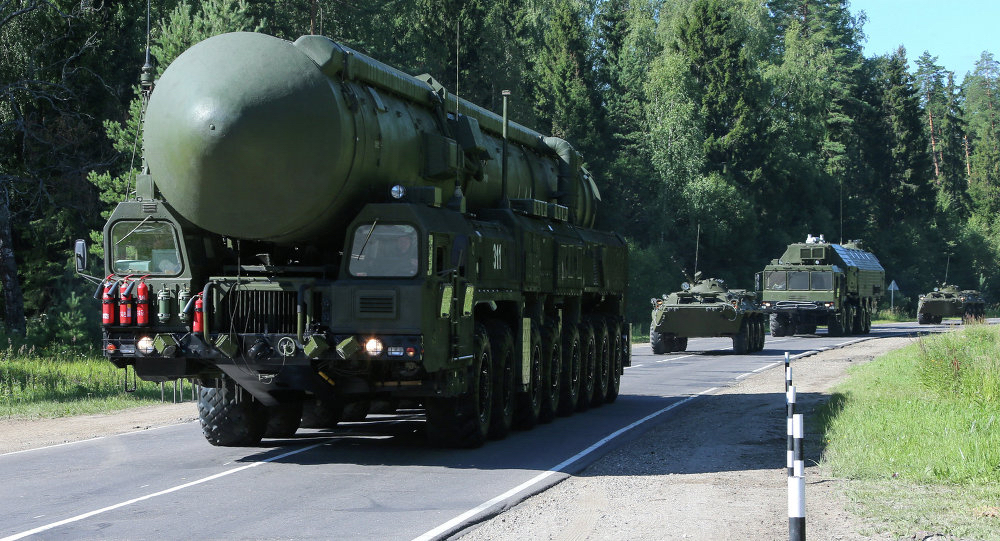
The New START data shows that Russia’s nuclear modernization program has not been trying increase the number of launchers despite a sizable gap compared with the US arsenal.
Instead, the Russian military appears to try to compensate for the launcher gap by increasing the number of warheads that can be carried on the newer missiles that are replacing older types (Yars and Bulava). Many of these warheads are not deployed on the missiles under normal circumstance, however, but stored and could potentially be uploaded onto launchers in a crisis. The United States also has such an upload capability for its larger inventory of launchers and therefore is not at a strategic disadvantage.
Two of Russia’s new strategic nuclear weapons (Avangard and Sarmat) are covered by New START if formally incorporated. Other types, which have become a sticking point for the Trump administration, are in relatively small numbers (if they have even been deployed yet) and do not appear capable of upsetting the strategic balance in the foreseeable future. The treaty includes provisions for including new weapon types.
Inspections and Notifications
In addition to the New START data, the U.S. State Department has also updated the overview of part of its treaty verification activities. The data shows that the two sides since February 2011 have carried out 328 on-site inspections of each other’s strategic nuclear forces and exchanged 20,871 notifications of launcher movements and activities. Nearly 1,200 of those notifications were exchanged since March 5, 2020.
Importantly, due to the Coronavirus outbreak, there have been no on-site inspections conducted since April 1, 2020. Treaty opponents might use this to argue that compliance with the treaty cannot be determined or that it shows it’s irrelevant. Both claims would be wrong because National Technical Means of verification also provide insight to activities on the ground, but that on-site inspections provide valuable additional data.
This inspection and notification regime and record are crucial parts of the treaty and increasingly important for US-Russian strategic relations as other treaties and agreements have been scuttled.
The 11th Hour
Time is now quickly running out for New START with only a little over four months remaining before the treaty expires on February 5, 2021. Rather than working to secure extension, the Trump administration instead has introduced last-minute conditions that threaten to derail extension.
Russia and the United States can and should extend the New START treaty as is by up to 5 more years. Once that is done, they should continue negotiations on a follow-on treaty with additional limitations and improved verification. It is essential both sides act responsibly and do so to preserve this essential cornerstone of strategic stability.
The fact that Marshall Billingslea has already threatened to increase US nuclear forces if Russia doesn’t agree to the US conditions for extending the treaty only reaffirms how important New START is for keeping a lid on US and Russian strategic nuclear forces and for providing transparency and predictability on the status and plans for the arsenals.
Additional background information:
Status of world nuclear forces, September 2020
This publication was made possible by generous contributions from the John D. and Catherine T. MacArthur Foundation, the New Land Foundation, the Ploughshares Fund, and the Prospect Hill Foundation. The statements made and views expressed are solely the responsibility of the authors.
Remembering Hiroshima and Nagasaki, 75 Years After
Seventy-five years ago, the United States conducted two nuclear attacks against the cities of Hiroshima and Nagasaki, Japan, devastating their populations and destroying their infrastructure.
In the process of manufacturing and testing the nuclear weapons that would eventually be used on Hiroshima and Nagasaki, civilians within downwind communities, nuclear workers, uranium miners and their families, and military personnel were also exposed to harmful and sometimes deadly levels of ionizing radiation. Following their use in Japan, the production and past testing of nuclear weapons in the United States and internationally continues to harm the health, environment, and cultures of communities around the world.
In the United States, we are commonly told that creating and dropping these nuclear bombs was “necessary” in order to end the Second World War and save additional lives. As several prominent historians have detailed extensively, this narrative is oversimplistic and ahistorical: the bombs were never intended to take the place of an invasion, and it is not even clear that they directly brought about the end of the war in the way that is often portrayed. Primary documents show that the commonly-taught narrative about the two atomic bombings can be easily deconstructed. Additionally, these nuclear bombings followed devastating conventional firebombings of Japanese cities that were specifically designed to target civilians and infrastructure.
Seventy-five years later, we commemorate the nuclear attacks and the unspeakable human suffering they inflicted, which remind us of the uniquely destructive capability of nuclear weapons and the importance of ensuring that they are never used in anger again.
In recognition of this 75th anniversary, the Federation of American Scientists is honored to join a coalition of nuclear weapons organizations and survivors in calling for our leaders to take the actions necessary to ensure nuclear weapons are never used again and to negotiate in good faith the global elimination of these most devastating weapons of mass destruction.
As our coalition statement reads,
Today, we are living in a time of extraordinary nuclear dangers. Vital international agreements to reduce and control nuclear weapons worldwide are being abandoned. Budgets for the development and production of new nuclear weapons are growing. Tensions among nuclear-armed nations are rising to levels not seen since the Cold War.
As the mayors of Hiroshima and Nagasaki warn: “We are badly off course in efforts to honor the plea of the hibakusha and end the nuclear threat.”
As the only country to use nuclear weapons in conflict, the United States has a moral obligation to lead the world in ending this menace and restoring communities impacted by nuclear weapons.
People created these weapons and designed the systems governing their use; people can work to eliminate them.
As we wrote on the 75th anniversary of the Trinity test, we are trending in the wrong direction. Despite reductions since the Cold War, there are still more than 13,000 nuclear weapons in the world, and every nuclear-armed country is currently in the midst of modernizing their nuclear arsenals. Disturbingly, bilateral and multilateral arms control agreements have fallen away or are currently under severe stress. Most immediately concerning is New START, which effectively limits US and Russian strategic warhead and launcher deployments, but expires in February 2021. As we have written, New START extension is a no-brainer: Russia and the United States can extend the New START treaty by up to 5 more years. It is essential both sides act responsibly and do so to preserve this essential agreement.
The Federation of American Scientists is honored to provide the world with the best non-classified estimates of the nuclear weapons arsenals. We are grateful for the financial support from the New Land Foundation, MacArthur Foundation, Ploughshares Fund, and the Prospect Hill Foundation to do this work. To explore this vast data, developed over many decades, start here.
75 Years Ago: The Trinity Nuclear Test
On this day 75 years ago, the world entered the nuclear age. The first ever nuclear detonation – known as the Trinity test – took place in New Mexico on July 16th, 1945. Since then, ten countries built more than 134,000 nuclear weapons. More than 13,400 remain today.
In the decades that followed, nuclear testing contaminated lands, oceans, and people, and triggered a nuclear arms race that continues to this day. The Federation of American Scientists is honored to join our colleagues at the Union of Concerned Scientists and Tularosa Basin Downwinders Consortium in a joint statement with five other U.S. organizations on the humanitarian consequences of nuclear testing, endured by victims in the United States and its Pacific territories, from French nuclear testing in French Polynesia and Algeria, Russian nuclear testing in Kazakhstan, British nuclear testing in Australia, and others.
In addition to these harms, the Trinity test marked the beginning of the global nuclear arms race with its endless cycles of nuclear modernization and competition, which continue to this day. Unlike any other invention, nuclear weapons have the capability to destroy human civilization and much or life on Planet Earth.
The Federation of American Scientists has tracked the rise and fall of global nuclear arsenals for many years. Despite reductions since the Cold War, there are still more than 13,000 nuclear weapons in the world. And we are disappointed to note the emergence of five disturbing trends regarding the current and future state of nuclear weapons:
- Every nuclear-armed country is currently in the midst of modernizing their nuclear arsenals. Some countries are actually increasing their stockpiles, while others are swapping out their older weapons with newer, more effective ones that will endure almost until the end of the 21st century.
- Not only are nuclear arsenals either increasing or improving, but it appears that many states are reinvigorating or even expanding the role of nuclear weapons – specifically tactical nuclear weapons – in their military doctrines. State representatives have often claimed that these deployments are actually intended to prevent conflict; however, regardless of how much stake one puts into that sort of statement, it is a fact that many states are now increasingly posturing themselves for nuclear warfighting. This development will make it more difficult to reduce the role of nuclear weapons and pursue significant reductions – and certainly disarmament – in the future.
- In recent years, we have also seen the decline – and general disinterest – in arms control writ large. Today, bilateral and multilateral arms control agreements have fallen away or are under severe stress, multilateral efforts to engage in good faith arms reductions appear to have completely stagnated, and states often seem more interested in blaming and shaming their prospective arms control partners than actually pursuing measures that would offer a modicum of transparency and predictability in an otherwise unpredictable world.
- Rather than pursue arms control, it seems that states are more content with pursuing arms competition and even arms races. This is a result of renewed military competition and is fueled by the tremendous influence that weapons contractors and lobbyists have on government decisions; indeed, sometimes nuclear decisions seem to be driven as much – if not more – by corporate interests than by national security concerns.
- Nuclear-armed states largely do not appear to consider nuclear disarmament to be an urgent global security, humanitarian, or environmental imperative. Instead, most states seem to consider disarmament as a type of chore mandated by the Non-Proliferation Treaty – and not one that they are seriously interested in completing in the foreseeable future. It is increasingly rare to hear any officials from nuclear weapon states express a coherent rationale for pursuing disarmament other than as a result of the obligation to do so under the Non-Proliferation Treaty. Moreover, they seem increasingly focused on shifting the disarmament responsibility onto the non-nuclear states by arguing they first must create the security conditions that will make nuclear disarmament possible.
Although the Trinity test took place 75 years ago, its destructive legacy continues to this day. And despite these harms, some politicians are even trying to return to an era of live nuclear testing. Resuming nuclear explosive testing would be taking a monumental step backward and would open the floodgates for worldwide resumption of nuclear testing and development of new nuclear weapons. Instead, on this 75th anniversary, we must look forward, try our best to reverse these worrying trends, responsibly reduce the arsenals and the role that nuclear weapons serve, and work towards a world eventually free from nuclear weapons.
The Federation of American Scientists is honored to provide the world with the best non-classified estimates of the nuclear weapons arsenals. We are grateful for the financial support from the New Land Foundation, MacArthur Foundation, Ploughshares Fund, and the Prospect Hill Foundation to do this work. To explore this vast data, developed over many decades, start here: https://fas.org/issues/nuclear-weapons/status-world-nuclear-forces/
The State Department’s Compliance Report Plays the Blame Game, Despite Offering Little Evidence
The State Department’s Bureau of Arms Control, Verification and Compliance yesterday released its annual “Compliance Report,” which provides a detailed overview of US (and other countries’) adherence to various treaty and agreement commitments.
The report’s publication comes at a critical time, as the Trump administration has spent the past few years––and the past three months in particular––dismantling the last vestiges of US commitments to the international arms control regime. The administration has recently declared that it is unlikely to extend New START, has withdrawn from the Open Skies Treaty, has alluded to an intent to resume nuclear testing, and has announced that it will “reinterpret” the Missile Technology Control Regime in order to allow the United States to sell armed drones to previously-forbidden countries.
In addition to its intended purpose––providing the official public US assessment of how other countries adhere to arms control treaties and agreements––the administration clearly sees the Compliance Report as a tool to provide justification for shedding treaties. As such, other countries might question the report’s conclusion that the United States is in full compliance with all of its international obligations, but that other treaty parties are not.
Several sections of the Compliance Report are missing both critical context about how and why certain treaties met their eventual ends, as well as actual evidence for some of its claims about the actions of its arms control partners. To that end, we have tried to fill in some of the blanks below.
The Intermediate-Range Nuclear Forces (INF) Treaty
The report assesses that throughout 2019, the United States was in full compliance with the INF Treaty––the landmark Cold War-era treaty that eliminated and banned all US and Russian ground-launched missiles with ranges between 500 and 5,500 kilometers.
Although this assertion appears to be technically correct and provides an extensive overview of Russian activities, it is missing some critical context. Both the United States and Russia suspended their respective obligations under the treaty in February 2019, and the treaty officially died in August 2019. Although it appeared that Russia had been violating the treaty for many years, we have argued that the Trump administration’s decision to finally kill the treaty was the wrong move, for several reasons.
Firstly, withdrawal established a false moral equivalency between the United States, who probably was not violating the treaty, and Russia, who probably was. It also put the United States in conflict with its own key policy documents like the Nuclear Posture Review and public statements made last year, which emphasized staying in the treaty while trying to bring Russia back into compliance through diplomatic, economic, and military measures. NATO preferred this approach until the Trump administration changed its mind and decided to withdraw, at which point NATO followed suit to avoid being seen to be in conflict with Washington.
The 2020 Compliance Report states that withdrawal from the INF Treaty was intended as a “remedy” for Russia’s material breach. But if the ultimate goal was to coax or coerce Russia back into compliance, then killing the treaty did the opposite. Instead, it legally freed Russia to deploy even more INF missiles on land, something the report explicitly warns that Russia might do by converting the SS-N-30a/Sagaris (Kalibr) sea-launched cruise missile into a land-based system. It also allowed the United States to explore developing INF-range missiles of its own. Only 16 days after the treaty’s collapse, the United States test launched a crudely-fashioned missile that would have certainly violated the INF treaty––if it had still existed.
New START
The 2020 Compliance Report notes that both Russia and the United States are in full compliance with the New START treaty, which caps the number of strategic nuclear warheads and delivery vehicles that each country is allowed to deploy. This is not newsworthy in itself; mutual compliance was confirmed by State and Defense Department officials during Senate testimony in 2018, after the February treaty deadline had passed.
It is bizarre that the Trump administration is using alleged Russian non-compliance with other treaties in order to undermine the one treaty with which Russia is actually complying. Moreover, unlike any other treaty mentioned in the Compliance Report, the strategic forces limited by the New START treaty are the only weapons of mass destruction that can threaten the very existence of the United States.
New START expires in less than a year, and while Russia has agreed to extend it unconditionally, the Trump administration has been dragging its feet. This should be a no-brainer: the treaty is a good deal for both parties, it offers a critical source of predictability and transparency into Russia’s nuclear forces, and extension is widely supported across the country, even among Trump voters; in fact, it’s one of the very few bipartisan issues still remaining in Congress. Senior military leaders, such as the Vice Chairman of the Joint Chiefs of Staff and the commander of Air Force Global Strike Command, have declared their full support for the treaty, largely because it offers a critical source of transparency and stability in the US-Russia nuclear relationship.
Specifically, during the 2018 Senate hearing, then-Under Secretary of State for Arms Control and International Security Affairs noted “The United States benefits from the Treaty’s 18 annual on-site inspections, notifications, and biannual data exchanges, which give us insight into the number of Russia’s strategic offensive arms subject to the Treaty and where they are at any given time.” She further noted, “Should the Treaty expire, U.S. inspectors would lose their current access to Russian strategic nuclear warheads and delivery systems, bases, and infrastructure, as well as the Treaty’s biannual exchange of data and associated updates on the location and status of Russia’s strategic offensive arms subject to the Treaty.” However, this fact hasn’t stopped Trump’s new arms control envoy Marshall Billingslea––an ardent opponent of arms control who opposed US ratification of the 1993 Chemical Weapons Convention and the 1996 Comprehensive Test Ban Treaty, and supported US withdrawal in 2002 from the 1972 Anti-Ballistic Missile Treaty––from inexplicably arguing the opposite point. In an interview with The Washington Times last month, he claimed that “The Obama administration negotiated a very weak verification regime […] which the Russians have been exploiting.” The basis for this claim has not been substantiated by other senior administration or military officials, and is not presented in the Compliance Report itself.
In his recent interview, Billingslea noted that a new or extended New START-style deal would necessarily have to include China. This makes no sense. The entire Chinese arsenal is thought to include about 320 warheads––a fraction of the 4,000-4,500 in the US and Russian arsenals––which is why China’s position has consistently been the same: it will not take part in trilateral arms control negotiations while this strategic imbalance remains.
Therefore, as we have previously argued in Forbes, killing New START because it doesn’t include China would do nothing to address the United States’ security concerns about Chinese nuclear forces. Instead, if limits on US and Russian strategic nuclear forces fell away and caused both countries to increase their nuclear forces, China might decide that it would need to increase its stockpile even further in order to adjust to the greater nuclear threat. This would further exacerbate a post-New START nuclear crisis.
Extension does not require Congressional approval; it simply requires a presidential stroke of a pen. Given that both countries benefit from the treaty, that both countries are in compliance, and that the United States’ NATO allies strongly favor an extension, this is a ripe piece of low-hanging fruit.
The Joint Comprehensive Plan of Action
The JCPOA (commonly known as the Iran Nuclear Deal), is not mentioned at all in the Compliance Report. This is not necessarily surprising, as the Trump administration officially withdrew from––and then violated––the deal in 2018. However, in recent weeks, Secretary of State Mike Pompeo has argued that the United States remains a party to the deal, and therefore could demand a reimposition of sanctions on Iran if an arms embargo is not extended past October. As Senator Elizabeth Warren correctly tweeted in response, “This makes no sense.” “To extend this arms embargo,” she noted, “the Trump admin is suddenly arguing that the US is a party to the same Iran Deal it abandoned.”
Pompeo’s unconvincing argument is undermined by his own former State Department top arms control official, who noted in her 2018 Senate testimony that the United States completed its “withdrawal from the arrangement on May 8.” Additionally, if the Secretary of State truly believed that the United States was still party to the treaty, why would it be excluded from his own department’s comprehensive annual assessment of US treaty obligations?
The absence of JCPOA is even more curious because Iran’s nuclear activities are covered extensively over seven full pages in the Compliance Report.
Nuclear Testing
The Compliance Report does not assess any country’s compliance with the Comprehensive Test Ban Treaty (CTBT) because the United States has not ratified it. The report repeats the Trump administration’s statement that it has no intentions to ratify the treaty, but nonetheless assesses that Russia and China may have conducted nuclear weapons tests that fail to meet the United States’ “zero-yield” standard. This assertion echoes the claims initially made by DIA Director Ashley during his remarks at the Hudson Institute in May 2019.
On Russia, the report states that the “United States assesses that Russia has conducted nuclear weapons-related experiments that have created nuclear yield.” But it adds in the next sentence that the “United States does not know how many, if any [emphasis added], supercritical or self-sustaining nuclear experiments Russia conducted in 2019.” A test that released nuclear energy from a canister would require Russian notification under the Threshold Test Ban Treaty (TTPT), which Russia has not provided. But the Compliance Report does not present any evidence but says additional information is included in a classified annex.
On China, the report is even more vague and circumstantial. It doesn’t explicitly accuse China of having conducted low-yield nuclear tests nor present evidence to that effect. Instead, the Compliance Report says a number of other activities “raise concern” about China’s adherence to the zero-yield standard of the United States and that “the United States cannot rule out the possibility that China could have conducted activities at its test site that are inconsistent with its moratorium commitment…” Details are hidden in a classified annex.
Open source analysists have not detected “any alarming activity” in this regard. Absent public evidence, both China and Russia have rejected the claims, with the Russian Deputy Foreign Minister “[urging] the United States to abandon the growing practice of misinforming the global community about what is happening,” and the Chinese Foreign Ministry spokesperson “[refusing] to dignify the groundless US allegation with a refutation.”
Claims about Chinese and Russian low-yield testing are not new, but are occasionally used by anti-arms control hawks working to hype the Russian or Chinese threat, in addition to pushing for the United States to resume nuclear weapons testing. It is unfortunate that this year’s Compliance Report echoed these claims without offering any public proof to back them up, and that would-be arms control killers are subsequently using them as “evidence” of cheating.
Presidential Nuclear Initiatives
A new addition to this year’s Compliance Report is a large section (three and a half pages) on the 1991-1992 Presidential Nuclear Initiatives (PNIs). This is an oddball because the PNIs were unilateral declaration, not treaties, without any verification. Apparently, including the PNIs is part of the administration effort to make the case that Russia is cheating and therefore can’t be trusted with other treaties such as the New START treaty.
Russia is cheating on one part of the PNIs, the report says, because Russia hasn’t eliminated all nuclear warheads for Ground Forces as it promised in 1991. The report explicitly identifies the SS-21 and SS-26 short-range ballistic missiles (the SS-26 is replacing the SS-21) as dual-capable. The report does not explicitly say Russian ground-forces have retained nuclear artillery, a frequent rumor on the Internet. Curiously, the SSC-8 GLCM is not mentioned in the PNI section, even though it is a ground-launched dual-capable weapon (it is addressed in the INF section of the report).
The big picture, of course, is that Russia has fulfilled most of the PNI promises and significantly reduced its inventory of non-strategic nuclear weapons since the 1990s. The Compliance Report only mentions in passing that “Russia continues to abide by some PNI pledges, such as warhead consolidation and likely the declared reduction in stockpiles…” Although Russia retains more non-strategic nuclear weapons than the United States (up to 2,000 according to the Nuclear Posture Review), that has been the case for the past three decades. Statements by US government officials indicate that Russia reduced its inventory of non-strategic nuclear weapons between 2009 and 2019 by more than one-third.
One thing completely missing from the Compliance Report’s assessment of the PNI issue is that US planned production of a new nuclear sea-launched cruise missile––as recommended by the Nuclear Posture Review––would be in violation of the United States’ own PNI pledge.
The Role of the Compliance Report
Violations of treaties and agreements must be addressed and resolved, which requires a persistent and professional level of engagement with other countries. Because the Trump administration is focused on abandoning treaties and reinvigorating “Great Power Competition” with Russia and China, however, the Compliance Report may increasingly be seen as a means to provide a justification for that agenda.
Even if Russia is cheating on some agreements, that doesn’t mean they will cheat on all of them, or that it is no longer worth it to retain the ones that are working. Russia has a clear interest in limiting US nuclear forces just as the United States and its allies have an interest in limiting Russian forces.
And even though China is slowly increasing its nuclear arsenal, that doesn’t mean that it is necessarily sprinting to parity. Even if the DIA’s projection that China will “at least double the size of its nuclear stockpile” over the next decade were to happen, that would still not bring the inventory anywhere near the size of the US or Russian stockpiles, which are currently estimated at 4,310 and 3,800 warheads, respectively.
There is also an expectation that if China increases its arsenal it will inevitably result in the abandonment of its no-first-use policy. In February, the head of US STRATCOM offered Senate testimony that he “could drive a truck through that no-first-use policy.” But others, such as Gregory Kulacki, have noted that China’s nuclear strategy is more restrained than what the public debate often assumes.
In sum, the annual Compliance Report should function as a way for the United States and its arms control partners to get on the same page about the status of their respective obligations and anticipate where future compliance issues might arise––not as a way to offer justifications for its own misdeeds. Otherwise, its publication may soon contribute to a breakdown in arms control altogether, rather than function as a mechanism to save it.
A Decade After Signing, New START Treaty Is Working
On this day, ten years ago, U.S. President Barack Obama and Russian President Dmitri A. Medvedev signed the New START treaty during a ceremony in Prague. The treaty capped the number of strategic missiles and heavy bombers the two countries could possess to 800, with no more than 700 launchers and 1,550 warheads deployed. The treaty entered into force in February 2011 and into effect in February 2018.
Twice a year, the two countries have exchanged detailed data on their strategic forces. Of that data, the public gets to see three sets of numbers: the so-called aggregate data of deployed launchers, warheads attributed to those launchers, and total launchers. Nine years of published data looks like this:
The latest set of this data was released by the U.S. State Department last week and shows the situation as of March 1, 2020. As of that date, the two countries possessed a combined total of 1,554 strategic missiles and heavy bombers, of which
1,140 launchers were deployed with 2,699 warheads (note: the warhead number is actually about 100 too high because each deployed bomber is counted as one weapon even though bombers don’t carry weapons under normal circumstances).
Compared with September 2019, the data shows the two countries combined cut 3 strategic launchers, reduced deployed strategic launchers by 41, and reduced the number of deployed strategic warheads by 103. Of these numbers, only the “3” is real; the other changes reflect natural fluctuations as launchers move in and out of maintenance or are being upgraded.
Compared with February 2011, the data shows the two countries combined have cut 435 strategic launchers, reduced deployed strategic launchers by 263, and reduced the number of deployed strategic warheads by 638. While important, it’s important to remind that this warhead reduction is but a fraction (less than 8 percent) of the estimated 8,110 warheads that remain in the two countries combined nuclear weapons stockpiles (less than 6 percent if counting their total combined inventories of 12,170 stockpiled and retired (but yet to be dismantled) warheads).
The United States
The data shows the United States currently possessing 800 strategic launchers, of which 655 are deployed with 1,373 warheads attributed to them. This is a reduction of 13 deployed strategic launchers and 3 deployed strategic warheads over the past 6 months. These are not actual reductions but reflect normal fluctuations caused by launchers moving in and out of maintenance. The United States has not reduced its total inventory of strategic launchers since 2017.
Compared with February 2011, the United States has reduced its inventory of strategic launchers by 324, deployed launchers by 227, and deployed strategic warheads by 427. While important, the warhead reduction represents only a small fraction (about 11 percent) of the 3,800 warheads that remain in the U.S. stockpile (a little over 7 percent if counting total inventory of 5,800 stockpiled and retired (but yet to be dismantled) warheads).
The Russian Federation
The New START data shows Russia with an inventory of 764 strategic launchers, of which 485 are deployed with 1,326 warheads attributed to them. Compared with six months ago, this is a reduction of 28 deployed launchers and 100 deployed strategic warheads and reflects launcher maintenance and upgrade work to new systems.
Compared with February 2011, Russia has cut its inventory of strategic launchers by 111, deployed launchers by 36, and deployed strategic warheads by 211. This modest reduction represents less than 5 percent of the estimated 4,310 warheads that remain in Russia’s nuclear weapons stockpile (less than 4 percent if counting the total inventory of 6,370 stockpiled and retired (but yet to be dismantled) Russian warheads).
The Russian reductions accomplished under New START are smaller than the U.S. reductions because Russia had fewer strategic forces than the United States when the treaty entered into force in 2011.
Build-up, What Build-up?
With frequent claims by U.S. officials and nuclear weapons advocates that Russia is increasing its nuclear arsenal, it is interesting that despite a significant modernization program, the New START data shows this increase is not happening in the size of Russia’s strategic nuclear forces.
On the contrary, the New START data shows that Russia now has 170 deployed strategic launchers fewer than the United States, a number that exceeds the size of an entire US Air Force ICBM wing. The Russian launcher deficit has been growing by more than one-third since the lowest point of 125 in February 2018.
The Russian military is trying to compensate for this launcher disparity by increasing the number of warheads that can be carried on newer missiles replacing older types. Most of these warheads are not deployed on the missiles under normal circumstance but stored and could potentially be uploaded onto launchers in a crisis. The United States also has such an upload capability for its larger inventory of launchers and therefore is not at a strategic disadvantage.
Two of Russia’s new strategic nuclear weapons (Avangard and Sarmat) are covered by New START. Other types are in relatively small numbers and do not appear capable of upsetting the strategic balance. The treaty includes provisions for including new weapon types.
Inspections and Notifications
In addition to the New START data, the U.S. State Department also recently updated its overview of the status of the on-site inspections and notification exchanges that are part of the treaty’s verification regime.
Since February 2011, U.S. and Russian inspectors have carried out 328 on-site inspections of each other’s strategic nuclear forces and exchanged 19,852 notifications of launcher movements and activities. Four inspections happened this year before activities were temporarily halted due to the Coronavirus.
This inspection and notification regime and record are crucial parts of the treaty and increasingly important for U.S.-Russian strategic relations as other treaties and agreements have been scuttled.
But time is now also running out for New START with only a little over 10 months remaining before the treaty expires on February 5, 2021.
Russia and the United States can extend the New START treaty by up to 5 more years. It is essential both sides act responsibly and do so to preserve this essential agreement.
See also: Count-Down Begins For No-Brainer: Extend New START Treaty
This publication was made possible by generous contributions from the John D. and Catherine T. MacArthur Foundation, the New Land Foundation, the Ploughshares Fund, and the Prospect Hill Foundation. The statements made and views expressed are solely the responsibility of the authors.
Count-Down Begins For No-Brainer: Extend New START Treaty
One year from today, on February 5, 2021, the New START treaty will expire, unless the United States and Russia act to extend the last nuclear arms control agreement for an additional five years.
No matter your political orientation, treaty extension is a no-brainer – for at least six primary reasons.
1. New START keeps nuclear arsenals in check. If the treaty expires, there will be no constraints on US or Russian strategic arsenals for the first time since 1972. It would remove caps on how many strategic nuclear missiles and bombers the two sides can own and how many warheads that are carried on them. This means that Russia could quickly upload about a thousand new warheads onto its deployed missile arsenal–without adding a single new missile. The United States could upload even more because it has more missiles and bombers than Russia (see table below). And both sides could begin to increase their arsenals, risking a new nuclear arms race.
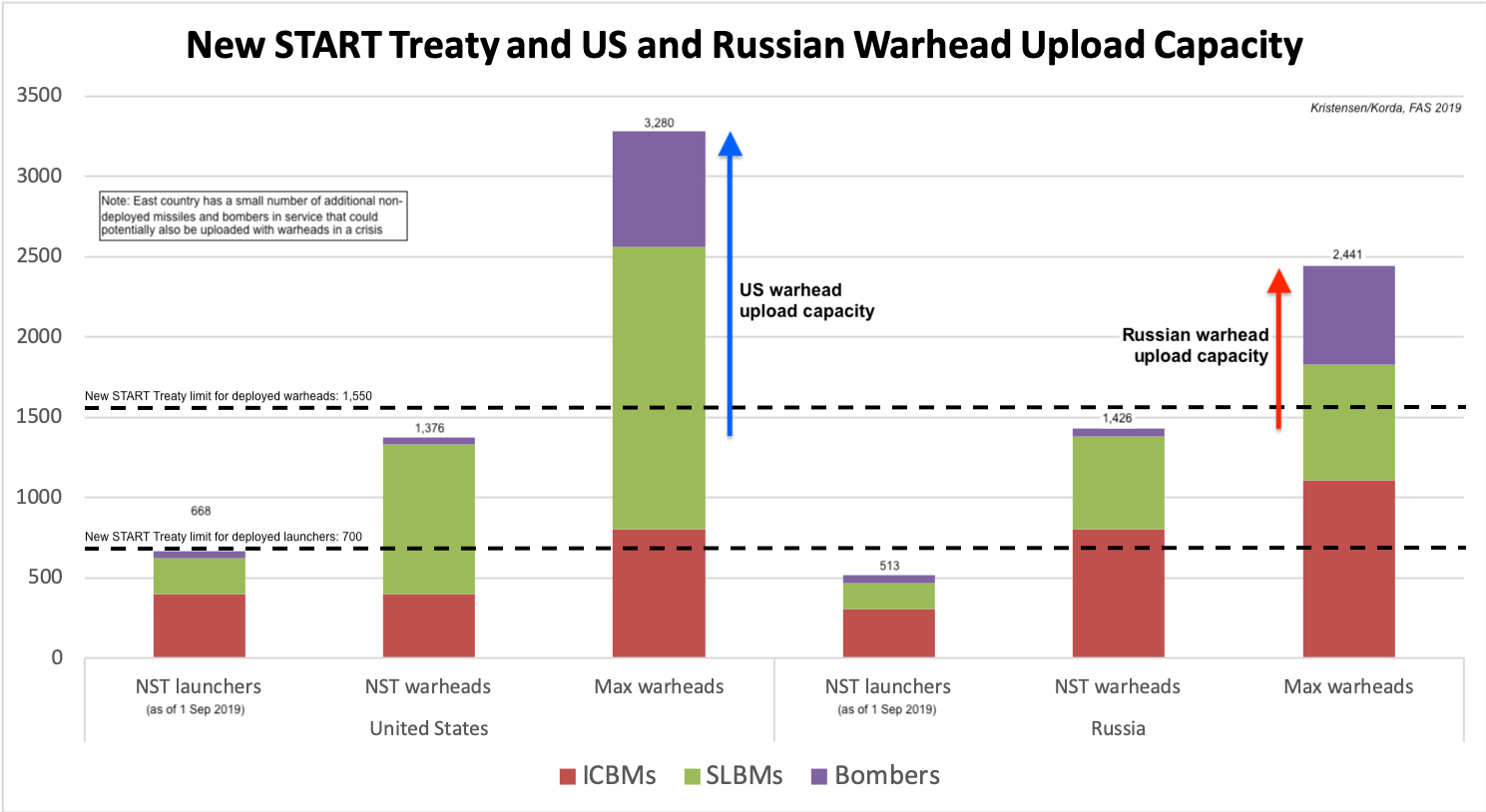
Both Russia and the United States have large warhead inventories that could be added to missiles and bombers if New START treaty expires. Click image to view full size
At a time when NATO-Russian relations are at their lowest since the end of the Cold War, when long-term predictability is more important than in the past three decades, allowing New START constraints to expire is obviously not in the US strategic interest or that of its allies. Very simply, New START is a good deal for both the United States and Russia; it cannot be allowed to expire without replacing it with something better.
2. New START force level is the basis for current nuclear infrastructure plans. Both the United States and Russia have structured their nuclear weapons and industry modernization plans on the assumption that the New START force level will continue, or at least not increase. If New START falls away, those assumptions and modernization plans will have to be revised, resulting in significant additional costs that neither Russia nor the United States can afford.
3. New START offers transparency and predictability in an unstable world. Under the current treaty, the United States receives a notification every time a Russian missile is deployed, every time a missile or bomber moves between bases, and every time a new missile is produced. Without these notifications, the United States would have to spend more money and incur significant risks to get the exact same information through National Technical Means (i.e. satellites and other forms of site monitoring). Russia benefits in the same way.

New START has forced Russia and the United States to reduce deployed strategic nuclear forces. Click image to view full size
Why would we willingly give all that up – to get absolutely nothing in return (and actually pay a steep price for giving it up)?
4. New START has overwhelming bipartisan support––even among Trump voters. Not only is extension a foreign policy priority for Democrats, but polling data indicates that approximately 70% of Trump voters across the country are in favor of extending New START.
Additionally, senior military leaders like the Vice Chairman of the Joint Chiefs of Staff and the commander of Air Force Global Strike Command have expressed support for the treaty. Even one of Trump’s own political appointees, Deputy Secretary of Defense for Policy David Trachtenberg, has testified that that “the transparency and verification requirements of the New START Treaty are a benefit” to the security of the United States.
5. We won’t get another chance. If New START expires next year, arms control between Russia and the United States as we know it is effectively over. Given the underlying East-West tensions and upcoming dramatic governance shifts in both the United States and Russia, there appears to be little interest or bandwidth available on either side in negotiating a new and improved treaty.
Moreover, although future arms control must attempt to incorporate other nuclear-armed states, efforts to do so should not jeopardize New START.
At risk of stating the obvious, negotiating a new treaty is exponentially more difficult than extending an existing one.
6. It’s easy. Extension of New START doesn’t require Congressional legislation or Senate ratification. All it takes is a presidential stroke of a pen. And at the end of 2019, Putin offered to immediately extend the treaty “without any preconditions.” President Trump should immediately take him up on his offer; as of today, he has exactly one year left to do so. But don’t wait till the last minute! Get it done!
Additional information:
- New START Treaty Data Shows Treaty Keeping Lid On Strategic Nukes
- The New START Treaty Keeps Nuclear Arsenals In Check And President Trump Must Act To Preserve It
- Overview: Status of World Nuclear Forces
This publication was made possible by generous contributions from the John D. and Catherine T. MacArthur Foundation, the New Land Foundation, the Ploughshares Fund, and the Prospect Hill Foundation. The statements made and views expressed are solely the responsibility of the authors.
China’s New DF-26 Missile Shows Up At Base In Eastern China
Pictures taken recently by Maxar Technologies’ satellites show a large number of launchers for the DF-26 intermediate-range missile operating at a training site approximately 9 kilometers (5.7 miles) south of Qingzhou City in China’s Shandong Province.
This is the first time the DF-26 has been seen operating in the area and marks a new phase in the integration of the missile into the Chinese military. The DF-26 is dual-capable, which means it can deliver both nuclear and conventional warheads and is thought to have a range of approximately 4,000 kilometers (2,490 miles). The DF-26 was first fielded in 2016 and the Pentagon’s 2019 report on Chinese military developments estimated China has up to 80 DF-26 launchers with 80-160 missiles (each launcher may have one reload).
The DF-26 is an INF-weapons, which means its range puts it in the category of ground-launched missiles that Russia and the United States banned in their arsenals for 32 years until Russia violated the treaty and the United States withdrew in protest.
China’s first DF-26 brigade stood up in April 2018 approximately 630 kilometers (390 miles) southwest of Qingzhou outside Xinyang in Henan Province. Over the past two years, DF-26s have appeared at several locations across China and significant production is visible at a factory outside Beijing.
DF-26 Sightings At Qingzhou
The Qingzhou site has been active for many decades and appears to be part of a missile support base operated by the People’s Liberation Army Rocket Force (PLARF). CIA initially identified the location as I-TU, a misspelling of its former name Yidu County, since changed to Qingzhou. The main base is located in the southwest district of the city [36.6774°, 118.4541°] and includes three large high-bay garages for servicing missile launchers. Over the years, several nuclear missile launchers have been seen operating there: DF-3A IRBM, DF-21 SRBM, DF-31/A ICBM, and now DF-26 IRBM.
The facility where the DF-26s recently appeared is about 9 kilometers (5.7 miles) of Qingzhou to the south near a location identified on Google Earth as Zhuanghanmiaocun. The DF-26 launchers first appeared there on satellite images in November 2019, when a dozen launchers were seen. In early January 2020, Google Earth loaded a Maxar image dated December 11, 2019 (note: image dates displayed on Google Earth are for some reason one day early compared to the actual date the image was taken), which was first described by Twitter user @DexReloaded. During December, several images taken by Maxar satellites show up to 18 DF-26 launchers, approximately the same number that was displayed at Xinyang in 2018 and at Jilantai in 2019.
The most recent image dated January 8, 2020, shows two groups of DF-26 launchers: one to the north (36.6026°, 118.4803°), between garages and on an old DF-3A circular launch pad; and a second group to the south (36.5999°, 118.4835°) on a cleared space where a former DF-31 launch pad is still visible. Also visible on the image are numerous support vehicles needed to support or repair the launchers when deployed. The DF-26 launchers are probably at the site as part of their integration into a new brigade.
DF-26 Sightings Elsewhere
As mentioned above, China stood up its first DF-26 unit in 2018. An image from the activation ceremony shows 24 trucks parked under a temporary cover: 18 DF-26 TELs and 4 support vehicles. If each brigade has 18 launchers, then the 80 launchers reported by the Pentagon would be sufficient for four brigades. Not all have become operational yet but DF-26s are beginning to appear at various sites across China: Xinyang (Henan), Qingzhou (Shandong), Dengshahe (Liaoning), Korla (Xinjiang), possibly Jinhua (Anhui), and the large training area at Jilantai (Inner Mongolia).
The standing up of the first DF-26 brigade at Xinyang in April 2018 was announced on Chinese news media with pictures and videos from the ceremony. But even before that, in January 2018, DF-26 launchers showed up at the field training site of the 651st Brigade near Dengshahe northeast of Dalian (Liaoning).
Then, in January 2019, Chinese media announced that DF-26s had carried out an exercise in the “Northwest China’s plateau and desert areas.” The operation was later geo-located to the large new training area west of Jilantai (Inner Mongolia), where they continued to train in April-May 2019 together with DF-41s, DF-31AGs, and DF-17s before being shipped to Beijing for the parade in September 2019.
DF-26 training at Jilantai has been a favorite propaganda tool for the Chinese government with several test-launches shown on various news media outlets (here and here). A propaganda documentary jointly produced by the Political Bureau of the Central Military Commission and the PLA News and Communication Center and broadcast by CCTV by the end of 2019 included a brief clip showing a DF-26 launch. The launch site is geolocated in the figure below:
During those months, DF-26 launchers were also seen operating at the 646 Brigade base in Korla (Ku’erle) in the Xinjiang province in western China. The first launcher was seen in April and two more in August 2019 (see image below).
DF-26 Production And Numbers
The Pentagon estimated in 2019 that China had fielded up to 80 DF-26 launchers. Not all of those are fully operationally deployed; some brigades are still being equipped. Noted China military expert Mark Stokes estimated maybe two or three DF-26 brigades a year ago, each with 6-12 launchers. So the display of 18 launchers at Xinyang and Qingzhou is obviously interesting: did it include 6-12 launchers from a second brigade or will DF-26 brigades have more launchers?
Eighteen launchers were also the number seen operating at Jilantai.
DF-26 launchers are produced at a factory near Fangshan in the outskirt of Beijing. The factory has been expanded significantly during the past decade with several large vehicle assembly halls added. The factory also appears to be involved in the production of DF-21 MRBM launchers as well as various air-defense systems. The main parking area for DF-26 launchers is in the middle of the southern end of the complex (see image below).
The first DF-26 launcher at Fangshan appeared on satellite images in March 2009 and four or five launchers were normally visible through 2016 when deployment began. The number of visible launchers increased in late-2017 and early-2018 to 15-25, and increased in late-2018 and early-2019 to 20-38 launcher, until reaching 51 visible launchers in early September 2019. Not all of the launchers seen were fully assembled; of the 51 launchers visible in September 2019, for example, only 38 appeared to be complete. The various stages of assembly are clearly visible on the images (see image below).
How does the Pentagon’s China report get to 80 DF-26 launchers? The report doesn’t explicitly say the 80 are fielded or deployed and the operational brigades and launchers seen at training areas do not add up to 80 – that number is less than 60. It seems likely the DOD estimate includes at least some of the launchers in production at Fangshan. As illustrated above, those launchers include some that are not finished but at various stages of assembly.
If one adds up all the Fangshan launchers that appear complete (those with missile canister installed), the number was about 40 in mid-2018, when DOD reported 16-30 launchers. By mid-2019, when DOD reported 80 launchers, the total number of completed launchers at Fangshan was about 50. Such a count does not accurately show how many launchers were complete because the available images were not evenly distributed over time; some were taken only a few days or weeks apart and there were month-long gaps between others. Nonetheless, it does indicate that the DOD estimate of 80 launchers likely included complete launchers at the Fangshan factory in addition to those deployed at the brigade bases and training areas.
DF-26 Implications
The “new” about the DF-26 is not that it can target Guam (other missiles have been able to do so for decades); it is that it can do so with an accurate conventional warhead. But there are also other reasons why the deployment of additional new DF-26s at Qingzhou and other locations, as well as the considerable production that is underway, is important.
The first reason is the growing size and diversity of the Chinese nuclear arsenal. China officially maintains what it calls a minimum deterrent focused on ensuring it has a secure retaliatory capability to respond to a nuclear attack. Compared with Russia and the United States, the Chinese nuclear arsenal is small; but compared with France, Britain, and India, the Chinese arsenal is significant. And it is increasing further with China about to overtake France as the world’s third-largest nuclear-weapon state. China’s arsenal has nearly doubled over the past 15 years and is expected to increase further over the next decade, although perhaps not as much as some say. There is no indication China is seeking numerical parity (or near-parity) with Russia and the United States or changing its nuclear strategy. Yet the apparently open-ended growth of the Chinese nuclear arsenal is deepening uncertainty and anxiety in neighboring countries and other nuclear-armed states about China’s long-term intentions.
China’s rejection of such concerns is well-known but counterproductive because it will fuel the development and deployment of military capabilities that China will see as growing threats to its national security. The Chinese government could help alleviate concerns and worst-case response by issuing factual statements about the status and future plans for its nuclear arsenal. This would not require disclosing everything, but as a growing military power, the days are over when China can hide behind the larger nuclear powers.
A second reason the growing DF-26 deployment is important is that it is a dual-capable weapon that can deliver either a conventional or a nuclear warhead. The inability to clearly distinguish the two creates significant challenges for crisis stability and escalation scenarios. In a tense crisis or a war, Chinese readying of conventionally-armed DF-26 launchers could easily be misinterpreted as preparations to employ nuclear weapons and cause an adversary to ready its nuclear weapons unnecessarily and precipitately. If China launched a conventionally-armed DF-26, the target country might assume the worst and prematurely escalate to nuclear use. This dilemma is exacerbated by the fact that the conventional DF-26 is part of the PLARF’s conventional missile strike force intended to provide pre-nuclear strike options, a force that in a potential war with the United States would likely be subject to focused and intense conventional strikes. If the United States used conventional weapons to target what it perceived was conventional DF-26 launchers, China might conclude that the United States had attacked its nuclear forces and escalate accordingly.
A fourth reason the growing DF-26 deployment is important is that the payload section is guided and, according to DOD, is “capable of near-precision strike capability” against land targets. Retaliatory nuclear deterrence does not require near-precision, but warfighting could. As such, Chinese deployment of highly accurate, quick-strike, dual-capable weapons could further deepen uncertainty and speculations about Chinese nuclear strategy. It could potentially also influence Chinese considerations about sub-strategic uses of nuclear weapons in de-escalation scenarios.
Finally, the DF-26 deployment is important because the missile is part of China’s growing inventory of INF-range weapons. Russia’s violation of the INF treaty was probably partially a response to China’s growing inventory of INF-range missiles, and the United States used China as part of its justification for withdrawing from the INF treaty and is developing several INF missiles that it plans to deploy within range of China. Russian and US deployment of INF missiles near China will likely further stimulate China’s production of INF-range weapons and potentially result in a destabilizing INF arms race in the Pacific.
For these reasons, it is important that China provides more information about its future plans for the development of its missile forces and engage in ongoing official discussions about the scope and role of its nuclear deterrent, including INF forces. And although China is unlikely to join US-Russian strategic agreements in the foreseeable future, Beijing should already now begin to develop options for what it could offer and what it would want in return if joining such agreements in the future. This could include articulating which US (and Indian) capabilities China is most concerned about and what Beijing would offer in return for limits on them. As a goodwill gesture, China could also offer unilateral limits on its INF capabilities in return for the US and Russia not deploying new INF systems in the region. Information and limits on the dual-capable DF-26 would be a good start.
This publication was made possible by generous contributions from the Carnegie Corporation of New York, the John D. and Catherine T. MacArthur Foundation, the New Land Foundation, the Ploughshares Fund, and the Prospect Hill Foundation. The statements made and views expressed are solely the responsibility of the authors.
New START Treaty Data Shows Treaty Keeping Lid On Strategic Nukes
The latest data on US and Russian strategic nuclear forces limited by the New START treaty shows the treaty is serving its intended purpose of keeping a lid on the two countries’ arsenals.
The data was published by the State Department yesterday.
Despite deteriorating relations and revival of “Great Power Competition” strategies, the data shows neither side has increased deployed strategic force levels in the past year.
The data set released is the last before the New START treaty enters its final year before it expires in February 2021. The treaty can be extended for another five years by the stroke of a pen, but arms control opponents in Washington and Moscow are working hard to prevent this from happening. If they succeed, the world’s two largest nuclear arsenals will be completely unregulated for the first time since the 1970s.
By The Numbers
The latest data shows that the United States and Russia combined, as of March 1st, 2019, deployed a total of 1,181 strategic launchers (long-range ballistic missiles and heavy bombers) with a total of 2,802 warheads attributed to them (see chart below). That is very close to the combined forces they deployed six months ago. These two arsenals constitute more strategic launchers and warheads than all the world’s other seven nuclear-armed states possess combined.
For Russia, the data shows 513 deployed strategic launchers with 1,426 warheads. That’s a slight decrease of 11 launchers and 3 warheads compared with March 2019. Russia is currently 187 launchers and 124 warheads below the treaty limit for deployed strategic weapons.
The United States deploys 668 strategic launchers with 1,376 warheads attributed to them, according to the new data, or a slight increase of 12 launchers and 11 warheads compared with March 2019. The United States is currently 32 launchers and 174 warheads below the treaty limit for deployed strategic weapons.
These increases and decreases since March 2019 are normal fluctuations in the arsenals due to maintenance and upgrades and do not reflect an increase or decrease of the force structure or threat level.
It is important to remind, that the Russian and US nuclear forces reported under New START are only a portion of their total stockpiles of nuclear weapons, currently estimated at 4,330 warheads for Russia and 3,800 for the United States (6,500 and 6,185, respectively, if also counting retired warheads awaiting dismantlement). Both sides could upload many hundreds of warheads extra on their launchers if New START was allowed to expire.
Build-Up, What Build-Up?
Both Russia and the United States are engaged in significant modernization programs to extend and improve their strategic nuclear forces. So far, however, these programs largely follow the same overall structure and are unlikely to significantly change the strategic balance of those forces. The New START data shows the treaty is serving to keep a lid on those modernization plans.
That said, both countries are working on modifications to their strategic nuclear arsenals. Russia has been working for a long time – even before New START was signed – to develop exotic intercontinental-range weapons to overcome US ballistic missile defense systems. These exotic weapons, which are not yet deployed or covered by the treaty, include a ground-launched nuclear-powered cruise missile (Burevestnik) and a submarine-launched torpedo-like drone (Poseidon). The Trump administration is complaining these new weapons should be included in the treaty. A third weapon, an ICBM-launched glide-vehicle commonly known as Avangard, is close to initial deployment and will be accountable under the treaty but would likely replace existing deployed warheads. All of these weapons are limited in numbers and insufficient to change the overall strategic balance or challenge extension of New START. The treaty provides for adding new weapon types if agreed by the two parties, although neither side has formally proposed to do so.
Russia is not at an advantage in terms of overall strategic nuclear forces and the new data shows it does not appear to try to close the significant gap that exists in the number of deployed strategic launchers – 155 in US favor by the latest count (up 23 launchers from March 2019). To put things in perspective, 155 launchers are the equivalent of an entire US ICBM wing, or more than seven Ohio-class ballistic missile submarines fully loaded, or more than twice the size of the entire US nuclear bomber fleet. If the tables were turned, US officials and hardliners would certainly be complaining about a Russian advantage. Given this launcher disparity, one could also suspect that Russia might seek to retain more non-deployed launchers for potential redeployment to be able to rapidly increase the force if necessary. Instead, the New START data shows that Russia has continued to decrease its non-deployed launchers (down 12 since March 2019).
Instead of trying to close the launcher gap, Russia is compensating for the disparity by maximizing warhead loadings on its new missiles to be able to keep overall parity with the United States. Since 2016, the New START data indicates that Russia has been forced to reduce the normal warhead loading on some of its ballistic missiles in order to meet the treaty limit for deployed warheads. This demonstrates New START has a real constraining effect on Russian deployed strategic forces.
Having said that, Russia could potentially – like the United States – upload large numbers of non-deployed nuclear warheads onto deployed strategic launchers if a decision was made to break out of the New START limits or the treaty was allowed to expire in 2021. Those launchers would include initially bombers, then sea-launched ballistic missiles, and in the longer term the ICBMs. Significantly increasing the force structure, however, would take decades to achieve because both sides have based their long-term planning on the assumption that the New START force level would continue.
The United States has dismantled and converted more launchers than Russia because the United States had more of them when the treaty was signed, not because Washington was handed a “bad deal,” as some defense hardliners have claimed. But Russia has complained – including in an unprecedented letter to the US Congress – that it is unable to verify that launchers converted by the US to a conventional role cannot be returned to nuclear use. The New START treaty does not require irreversibility, however, and the US insists the conversions have been carried out in accordance with the treaty provisions that Russia agreed to when it signed the treaty.
The Russia complaints about converted launchers and the US complaints about incorporating new strategic weapons are issues that should be resolved in the treaty’s Bilateral Consultative Committee (BCC).

The US complains new Russian strategic weapons should be included in New START and Russia complains it can’t verify irreversibility of converted US launchers
Verification and Notifications
Although not included in the formal aggregate data, the State Department has also disclosed the total number of inspections and notifications conducted under the treaty. Since February 2011, this has included 313 onsite inspections (25 this year) and 18,803 notifications (2,387 last 12 months). This data flow is essential to providing confidence and reassurance that the strategic force level of the other side indeed is what they say it is. It also provides each side invaluable insight into structural and operational matters that complements and expands what is possible to ascertain with national technical means.
What Now?
Although bureaucrats and Cold Warriors in both Washington and Moscow currently are busy raising complaints and uncertainties about the New START treaty, there is no way around the basic fact: New START is strongly in the national security interest of both countries – as well as that of their allies.
But the treaty expires in February 2021 and the two sides could – if their leadership was willing to act – extend it with the stroke of a pen.
Unfortunately, Russian complaints that it is incapable of confirming US conversion of strategic launchers, US complaints that new exotic Russian weapons circumvent the treaty, Russia’s violation and the US decision to withdraw from the INF treaty, as well as the growing political animosity and bickering between East and West, have combined to increase the pressure on New START and put extension in doubt.
This all captures well the danger of Cold War mindsets where nationalistic bravado and chest-thumping override deliberate rational strategy for the benefit of national and international security. Bad times are not an excuse for sacrificing treaties but reminders of the importance of preserving them. Arms limitation treaties are not made with friends (you don’t have to) but with potential adversaries in order to limit their offensive nuclear forces and increase transparency and verification. If officials focus on complaining and listing problems, that’s what they’ll get.
It is essential that Russia and the United States decide now to extend the New START treaty. Without it, the two sides will switch into a worst-case-scenario mindset for long-term planning of strategic forces that could well trigger a new nuclear arms race.
Additional information:
- FAS Nuclear Notebook: Russia nuclear forces, 2009
- FAS Nuclear Notebook: US nuclear forces, 2019
- Status of world nuclear forces
This publication was made possible by generous contributions from the Carnegie Corporation of New York, the John D. and Catherine T. MacArthur Foundation, the New Land Foundation, the Ploughshares Fund, and the Prospect Hill Foundation. The statements made and views expressed are solely the responsibility of the authors.
